The above is not a rhetorical question. And the complete stating of it is: "Who was, and who was not, Billy Lovelady?" First, know that there is only one reliable image of him, and that is the one taken or commissioned by Mark Lane in the winter of 1964.
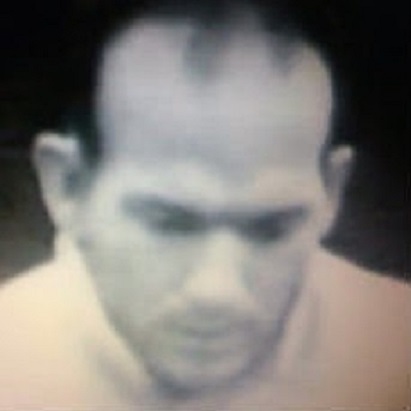
Every other image of him is either entirely bogus, where it’s not him at all, OR it is him but the image has been highly altered to make him look more favorable to being the Doorway Man. The two most important things to notice about the Mark Lane photo of Billy Lovelady are: how little hair he had at the time of the assassination, and the fact that he had clinically protruding ears. When ears stick out from the head by 2 cm or more, they are considered to be clinically protruding or prominent ears. Billy Lovelady had them. In this collage of Doorman, Oswald, and Lovelady, it jumps out at you that Doorman’s ear was Oswald’s- not Lovelady’s. How could anyone think otherwise?
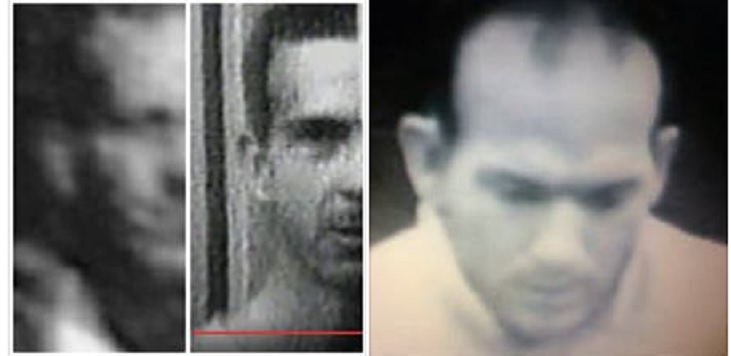
So, that guy with the protruding ears was the real Billy Lovelady. But now, we're going to look at the various bogus and altered images of him- no two of which look the same. We'll start with the FBI photos below, which were taken 29 February 1964. Notice that you don't see the protruding ears. They got rid of them, and in the center image, isn't the right ear (on our left) too low? It's really him, but we know very well that this image was tampered with. Besides replacing his protruding ears, his hair was greatly enhanced, and his face softened with shadow. We'll say more about that later.
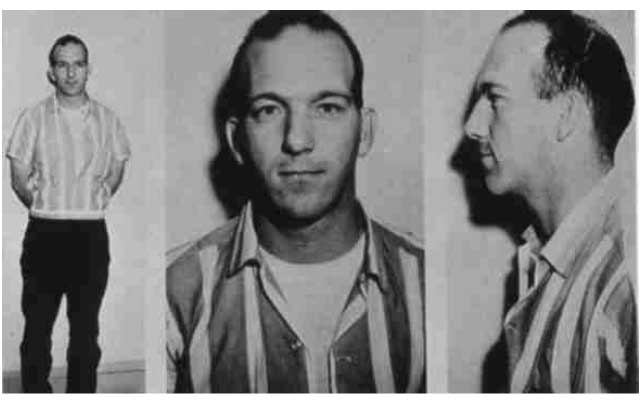
There is also a "hard" version of the FBI photo which you can see on the left below.
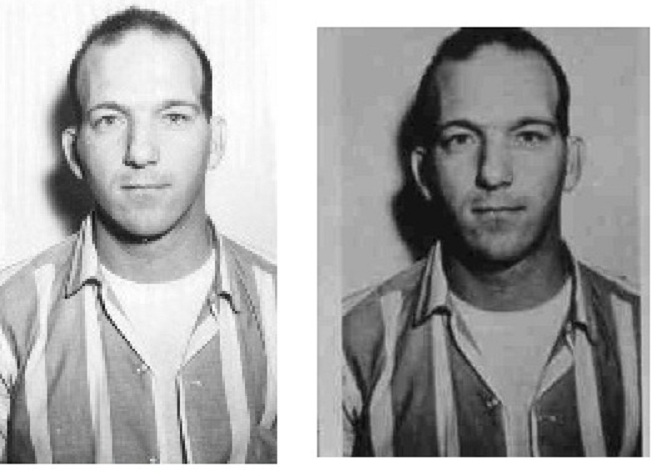
Obviously, the lighting is very different. Using harsh light, they gave him a decidedly hard look on the left, whereas on the right, shadow was used to soften his look, and the very existence of these two versions of the FBI photo is troubling. It proves that it is manipulated, crafted image, designed to sell the idea that he was Doorman. But for now, notice that his shirt was unbuttoned, and that's because, at the time, he was posing as Doorman. So, as late as March 1964, he was still saying that the shirt he wore on 22 November 1963 was the red and white, striped, short-sleeved one, shown above. That he was apparently asked to unbutton his shirt, which was not his usual practice, appears to have been the FBI's best effort to convert him into Doorman.
We don't know the exact date, but it was approximately May 1964 that Lovelady started claiming to be Doorman. Prior to that, others said it; but, that's when he started saying it. That's when Billy changed his story and started saying that he had worn the plaid, checkered, long-sleeved shirt. His earlier statement, which had been formalized in an official FBI report, was declared to be a misstatement even though the FBI had already sent it to the Warren Commission. In rather plain and unambiguous language, they stated that Lovelady said he wore the red and white striped shirt. See below.
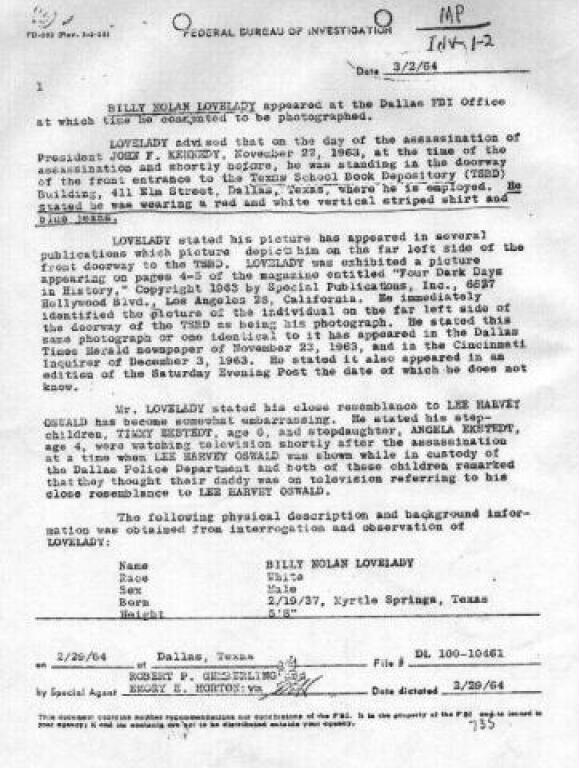
There are no still photographs of Billy wearing a plaid shirt on 22 November 1963. However, there are several movies which are clamed to show him wearing a plaid shirt that day, where frames from those movies have been converted into photographs. Let's analyze those photographs now because they are all bogus The first didn't appear until 1966, 3 years after the assassination. The second appeared in 1977 during the HSCA. And the third, which was a revision of the second, did not appear until 2009. Here's the first.
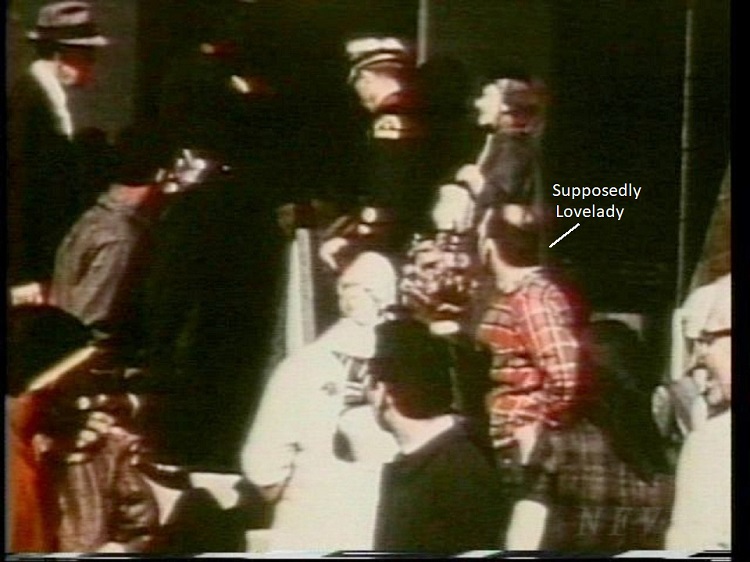
The first photograph was taken from what has been called the "Jack Martin post-assassination footage." Jack Martin was an amateur photographer, who, like Abraham Zapruder, shot a film of the motorcade as it drove through Dealey Plaza. Martin's film of the motorcade took twenty-five seconds, which you can watch here:
http://www.youtube.com/watch?v=n8dLonVQTRA
Dr. Wrone informed us that Martin, a postal worker, sold his film to Life magazine, and then Time-Life Inc. lent it to the FBI. And after that, lo and behold, a separate segment of it turned up with this Gorilla Lovelady standing outside the TSBD, and it was said to be part of the Martin film. Yet, he looked neither like Doorman, nor like anyone who could be mistaken for Oswald, nor even like Lovelady. The "unblushing corruption" of it all, to use a favorite expression of Dr. Wrone, is staggering. Where did they get the nerve to claim that this guy was Lovelady? And, they didn't discover this until 1966, three years after the assassination.
In the extant Martin film, you see the motorcade from the time it entered Dealey Plaza until it was racing off to Parkland Hospital, but you don't see Billy Lovelady. He only appears in the separate six-second clip that was supposedly taken outside the TSBD after the assassination. How did that six-second, post-assassination clip become physically separated from Martin's film of the motorcade? We know Jack Martin didn't separate it. Did Life magazine? Did the FBI? If so, why? Was it ever really a part of the film, or did they just make that up? You know: lie.
The fact that, qualitatively, the post-assassination footage is far superior to the motorcade footage suggests that it was taken separately by a different camera using different film and then was introduced as having been taken by Martin -- a rather clumsy attempt at fakery. But then, not all those who were involved in framing Oswald were rocket scientists.
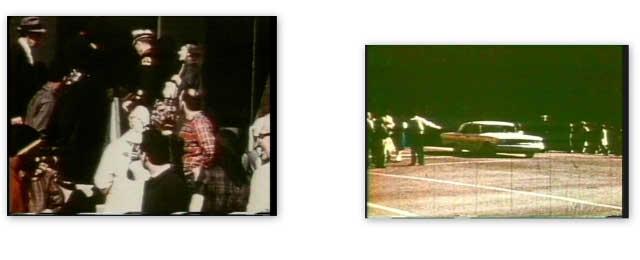
Consider for yourself: Do the two frames above look as though they were taken with the same camera? Doesn't the frame with Lovelady on the left look, qualitatively, much better than the grainy, fuzzy, drab photo on the right? This is not a trick question. Their gross differences are glaring proof that they were not taken with the same camera using the same film. Their differences are too great.
Indeed, the claim that this 6 second clip of Lovelady outside the TSBD came from Martin has never been substantiated or proven. It has simply been accepted by everybody, except us. But, that being said, let's compare Lovelady from the so-called Martin film to FBI Lovelady.
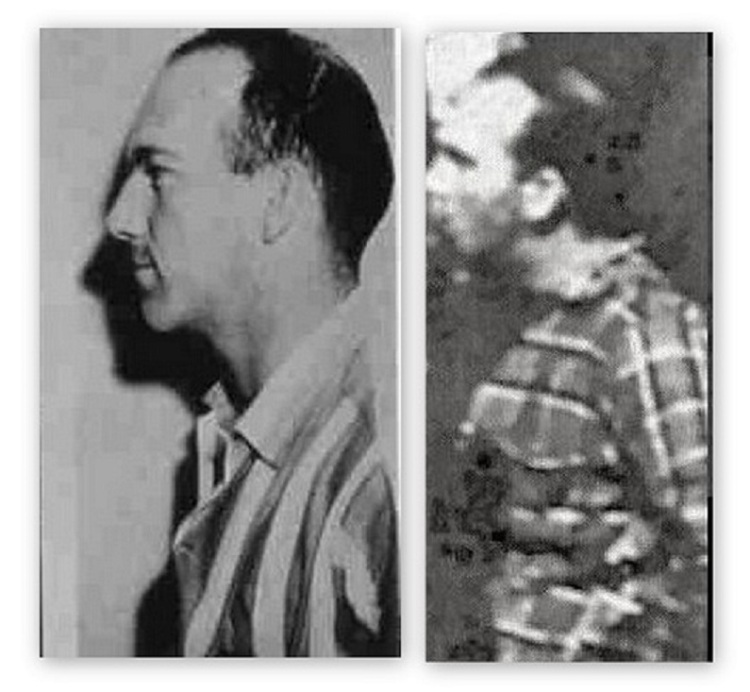
Again, the FBI photo was doctored, but it's the only profile image of Lovelady that we have. These two men cannot possibly be the same man. The shapes of their skulls are vastly different. Many of their facial features are different. Their necks are totally different. One looks like a gorilla, while the other does not. They are clearly different men. So what do they have in common? A similar pattern of hair loss, but even that isn't identical. Nothing else about them is even remotely close, never mind identical.
For ease in communication, we'll refer to the softer-looking Lovelady on the left as FBI Lovelady and the harder-looking Lovelady on the right as Gorilla Lovelady, since he happens to look like a gorilla. We don't think he was from the Martin film, even though that is claimed, but we'll put that aside for now. Here are five key differences between them:
(1) Gorilla Lovelady's head (right) is wider from front to back than is FBI Lovelady's (left). The ratio of the width of their heads to the height of their heads appears strikingly different.
2) The slope of FBI Lovelady's forehead is more vertical, and the angle of his forehead with the top of his head is more rectangular. On Gorilla Lovelady, there is no angle at all, rather there is just a long extended slope, like a ski slope, which reminds us of a Neanderthal caveman. And that's why we call him Gorilla Lovelady.
(3) FBI Lovelady has a long nose, while Gorilla Lovelady has a shorter, stubbier nose, and you just have to glance back and forth to see it.
(4) Their hairlines are different. FBI Lovelady's hairline at the temple seems to go straight up whereas Gorilla Lovelady's hairline angles back more.
(5) Their ears are very different, with FBI Lovelady's on the left being longer and narrower and more tapered at the bottom. Gorilla Lovelady has a much more compact ear. It is known in forensics that ears are as distinctive and unique as fingerprints.
But there is yet another difference between the two of them which jumps out even more at Dr. Cinque because of his background as a chiropractor: their necks. Gorilla Lovelady has a condition known as FORWARD NECK SYNDROME. Any orthopedist or chiropractor can see it at a glance. Instead of going up, his neck is going forward.
FBI Lovelady has a much more vertical neck. The basic, fundamental direction that it is going is UP. But on Gorilla Lovelady, his neck is going as much FORWARD as it is up, which has the effect of shortening his neck. And that is something we can measure. Take a ruler and measure the length of the visible neck on each of them, going from the bottom of the ear to wherever the vertical line reaches the shirt. You'll find that FBI Lovelady has about 50% more length to his neck.
Next, drop a plumb line on each of them. And the way to do that is to take a ruler and place it right behind the ear, and holding it vertically, track it down and see where it goes. With good posture, the ear should not be too much in front of the sagittal plane of the shoulder, and FBI Lovelady is doing quite well in that respect. His alignment isn't bad. But Gorilla Lovelady's ear is much farther forward than that; his plumb line is well forward of his shoulder. He is really quite contorted, and he seems headed for pain.
In having his neck forward like that, he has to do something to maintain his eyes level, that is, parallel with the ground, and what he's doing is cocking his head back sharply at the very top of his neck. If you were to see it on an x-ray, it would jump out at you that he is pinching his head back. So, his neck is going forward, and at the very top of his neck, his head is rocking back on his neck. And that is like putting a heavy weight on a spring, compressing it. It puts pressure on all the cervical joints, and over time, they wear out from it. The compressed cervical discs thin out until they are practically gone. Over time, cervical disc herniations are likely to occur with this kind of posture.
Here's another way you can tell the difference: look at the axis of FBI Lovelady's ear. It's pretty much vertical: straight up and down. Not perfectly vertical, but close. But, on Gorilla Lovelady, his ear is rocked back more. It's got more pitch to it. The line of greatest length through the ear is more diagonal, with the upper part back and the lower part forward. Again, it's rocked back, and the reason it's rocked back is because the whole head is rocked back. This is a very rigid, locked, dysfunctional posture that compromises mobility, flexibility, and coordination.
Ralph says that, as a chiropractor, it is a pleasure for him to look at FBI Lovelady because he has such nice lengthening in his neck, and that translates into freedom of motion, lightness of being, and a generally expansive state of the body, which is desirable. But, it's very disconcerting for him to look at Gorilla Lovelady because he looks solid, rigid, steeped in stiffness, and destined for pain.
Is there any chance that Lovelady was just standing and comporting himself differently on those two days? No. There is absolutely no chance of that. Postural habits are deeply ingrained. They are the MOST deeply ingrained of all the habits people have. And it's extremely hard to break them- even if you try, and there is no reason to think that Lovelady was trying.
And the reason that it's so hard to change them is because your habitual way of carrying yourself is the only thing you know; it's the only thing that feels right to you; anything else would feel out of balance and terribly wrong, like you were going to fall. It's like your own little world that you are living in, with your own personal way of responding to gravity and other forces- and it's the only one you can conceive of.
Having been a chiropractor for 36 years, Ralph observes that this one factor of the FORWARD NECK SYNDROME on Gorilla Lovelady and its absence on FBI Lovelady completely eliminates any possibility that they were one and the same man. It settles it as much as different dental x-rays. It is not just a different position that Gorilla Lovelady is assuming; he is anatomically different. He could not make his neck look like FBI Lovelady's no matter what he did; it's impossible.
Gorilla Lovelady was an imposter. He was not Lovelady, and he was not Doorman either. And now, we shall compare him to Doorman:
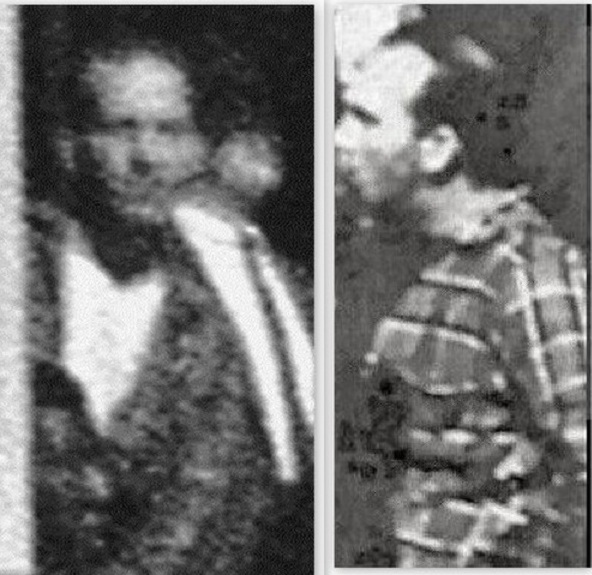
First, Doorman's shirt is sprawled open, and Gorilla Lovelady's shirt is not. This was supposed to be just a scant few minutes after the assassination and essentially in the same place- outside the TSBD. Are we to assume that Lovelady had the frame of mind to re-configure himself in the immediate aftermath of the assassination? And if so, don't you think that somebody should have asked him about it? Nobody did.
Second, doesn't the man on the right look quite a bit stockier? Don't you have the sense that he is quite a lot heavier? We never had that sense when comparing Doorman to Oswald, where they always seemed to be the same size and the same build.
Third, when you compare the shirt patterns, both look "varied" and "complex" but they are certainly not identical. This isn't horseshoes or hand grenades, so close doesn't count. Furthermore, we now know that the splotchyness of Doorman's shirt is due to haze and distortion. That's all it is. Without that, his shirt just looks grainy. And notice that Gorilla Lovelady has pattern all the way up to and including his collar. Now look at Doorman's upper right side (on our left). Doesn't it just look bland and grainy, like Oswald's? In no version of the Altgens photo does Doorman's shirt look checkered. Checkered means horizontal and vertical lines crossing and forming boxes. Gorilla Lovelady's shirt is strewn with boxes; there is not a single box on Doorman's shirt.
Fourth, look at the left side of Doorman's shirt on our right, the margin of it. Doesn't it look thicker and more substantial than the flimsy margin on the other side? Doesn't it look about twice as thick? It was twice as thick, as it was folded over into a long lapel on that side. But now look at Gorilla Lovelady. Do you see a lapel on him? No, it just a regular shirt with a regular collar and the standard lay. But, Doorman's shirt looks more like what we saw on Oswald with the long jacket-like fold down the left side.
Fifth, doesn't Doorman's face have a rather soft look, whereas Gorilla Lovelady's has a very hard look? Granted, those are subjective qualities, but still, they are discernible. The guy on the right looks like a caveman; the guy on the left does not. Both visually in terms of specifics, and intuitively in terms of the general impression, these two look like vastly different men.
So, where did Gorilla Man come from? They stuck him in there. It was a video merger, a technological trick. Was it possible in 1966? Most definitely. They were doing video mergers as early at 1945. Check out the movie Anchors Aweigh with Gene Kelly.
Now let's also compare Gorilla Lovelady, supposedly from the Martin film, to Hughes Lovelady, which was another film. It was supposed to be the same man at the exact same moment in time and space. Whoops! In one, his shirt is cinched up, and in the other, it is sprawled open. It's easy to lose track of details when you are making phony movies.
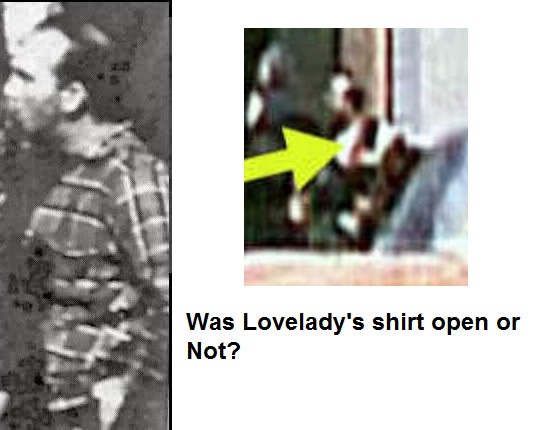
You should take a close look at that Hughes Lovelady above on the right. Do you notice that he looks like a cartoon? Yet, they actually claim that he is a photographic image. And notice that his shirt does not look plaid, rather, it looks geometric with large blocks and wedges in red, black, and white. Why is that? There is a simple explanation, although it eluded me for years. It's because that figure from the Hughes film was implanted, and for the first second or two, it was an unstable, distorted image, and that is what we are seeing. And apparently, someone went ahead and photoshopped that distorted image. And they went ahead and gave him a ridiculous Mohawk hairstyle as well. Again: people actually point to that figure as an example of Billy Lovelady on 11/22/63 from the Hughes film, even though he looks more like a cartoon than a photograph. Below, there is another example of it. He looks nothing like the real Lovelady, nor does he look anything like the Altgens Doorman. He doesn't even look human; he looks like a freak.
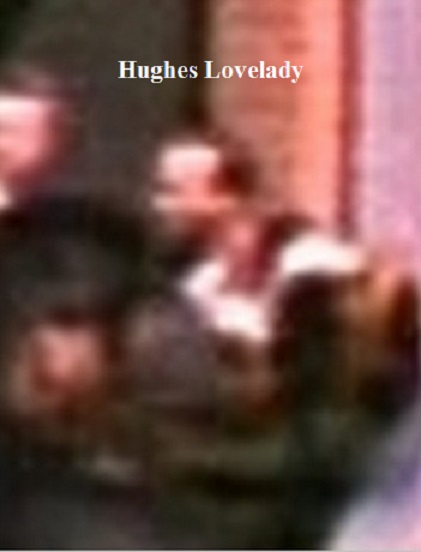
Eventually, his image settled down to what you see below, which looks relatively normal, having lost the freaky aspects. But, it still isn't Lovelady. You can be absolutely certain that he is not Billy Lovelady, and he does not look remotely like him. He is a photographic fraud.

Now, let's look at another movie, supposedly of Lovelady, from 22 November 1963. This film was taken at the Dallas Police Department (DPD) where Lovelady was waiting to make a statement. Supposedly, he was sitting at a work-desk in the squad room of the Homicide detectives (their inner sanctum) as Lee Harvey Oswald was led by:
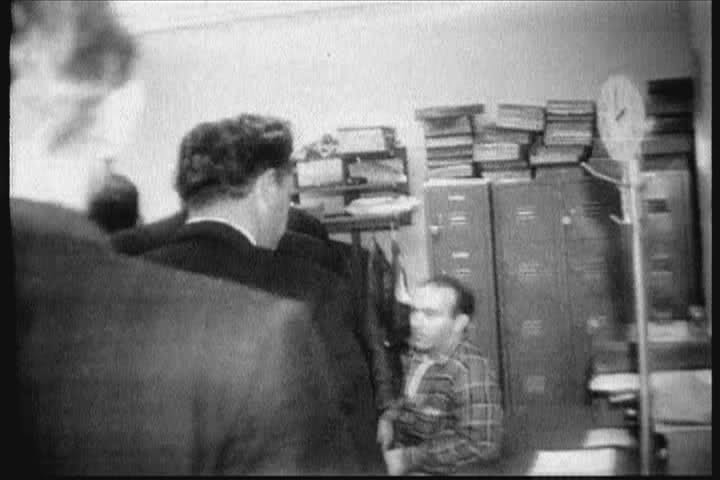
Does that look like the real Lovelady? Let's compare him to FBI Lovelady. He's got a much bigger head- a truly massive cranium- and he's got a heavier, more muscular build. He is indeed an imposter, although not the same imposter as Gorlla Lovelady. Look at them both and compare them both to FBI Lovelady.
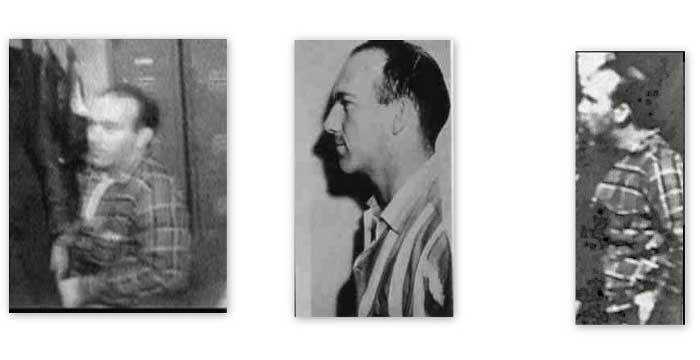
They are three different men. Putting it brusquely, in the middle is the real Billy Lovelady from his FBI photoshoot; on the left is a beefier guy with a face like Robert DeNiro; and on the right is a guy who looks like a Neanderthal caveman. They are all supposed to be Billy Lovelady, but only the middle one is.
But, a further problem with the DPD film is that there are at least two versions of it, where in the other version, yet another guy appears as Lovelady. Here are the two different Loveladys, side by side, from the two different versions of the squad room scene:
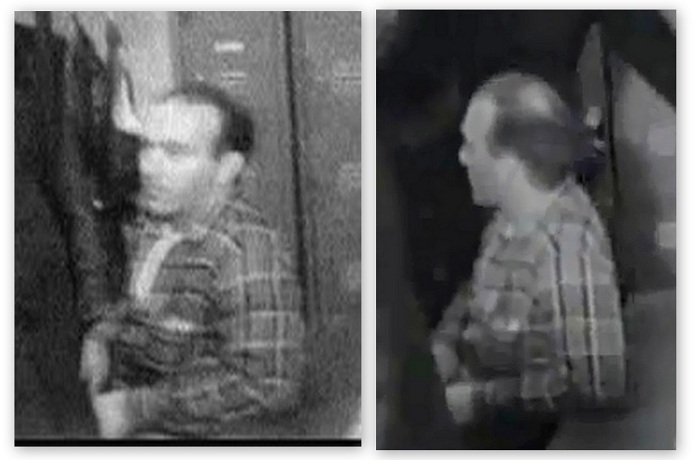
The Lovelady on the left we refer to as DeNiro Lovelady because he reminds Ralph of a young Robert DeNiro, although with a thicker, heavier build. We don't know who the Lovelady on the right is, except that he is a different man. Do you notice how much stockier DeNiro Lovelady is? He has got to weigh at least 30 pounds more than the other guy, and that is being conservative. Look at his massive arm. Look how DeNiro's shirt is spread open in a weird rectangular way, while the other guy's shirt is not. Look at the different direction of their hair: DeNiro's is combed straight back, while the other's is parted and combed over from the left to right. It's supposed to be the same man at the same moment in time and space. Look at the larger head on DeNiro and the greater depth to his head. These are different men. And yet, they are supposed to be the same man, the same situation, the same second. Are you buying it? They are even turned oppositely. The Lovelady on the right was done first, sometime in the 1970s. The other Lovelady on the left was done much later, possibly in the 21st century, and it was meant to be a vast improvement over the first. And, it involved a reenactment. Essentially, they added him and replaced everybody else as well but kept the background of the room. They went to a lot of trouble. In the first version, they just installed the Lovelady figure and that's all.
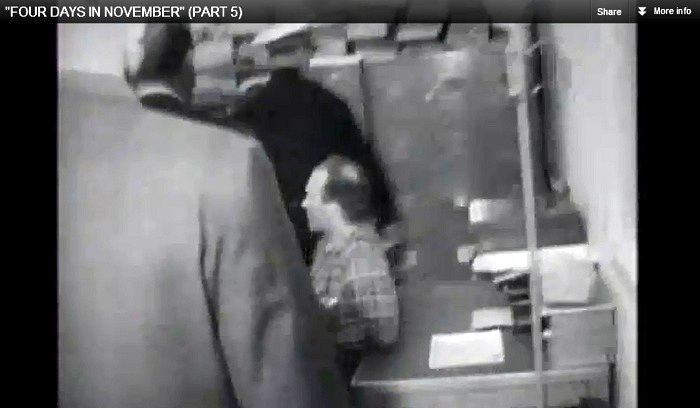
Here are the reasons why we believe the Lovelady figure above was embedded into the film. (1) In the movie, Lovelady, at times, has a white glow, where his lighting is strange and different. He seems to be illuminated, and he almost looks like a cartoon character. You can see an example of it in the image above. Do you see how white he looks? Not all the frames of him are like that, but some of them are. He was implanted. Even by 1964, the technology existed to do this. That's when the film Mary Poppins came out, so the technology to embed one video into another existed. Here are some examples from that film:
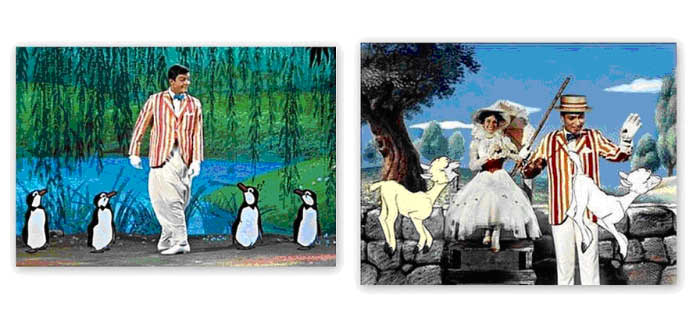
We also notice that, in Youtube versions, this Lovelady tends to bleed. Look again at the image above the cartoons and you can see the black bleed along the bottom of his forearm and behind his shoulder. Below is another frame in which his hair bleeds back creating a ducktail effect.
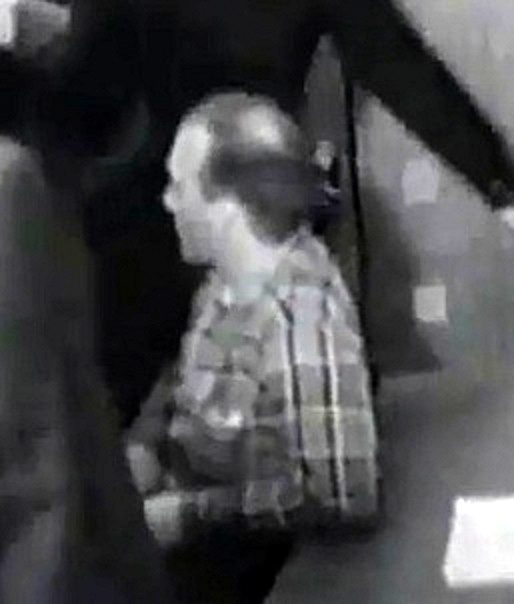
Isn't that weird? It almost looks painted on with a brush. That, no doubt, is distortion, but you see such distortions frequently on him, but you don't see such distortions on anyone else- only on him. Apparently, the constitution of the superimposed image is unstable and does not hold up well in a digital environment.
Here is another interesting proof that this Lovelady is fake. Look at the position of his arms. His left elbow is resting on the table. At first glance, it looks like his right elbow is doing the same, but look closely: it's miles away from the table. He can't be resting it on the table, and there's nothing else there to support it.
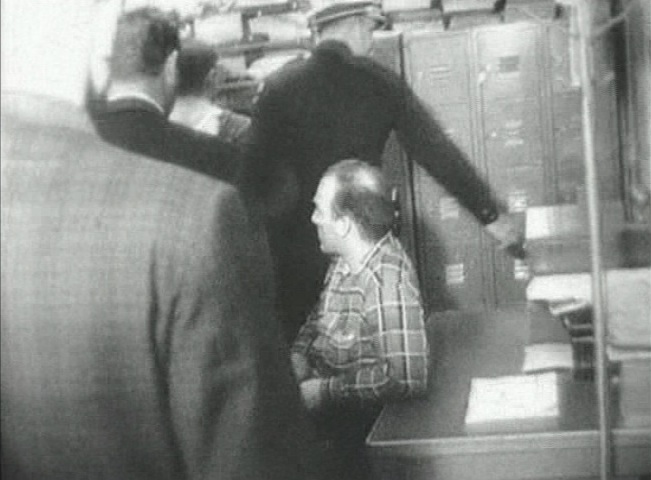
The next floor down for his right arm is his lap, but if he were resting it on his lap, that would shift the whole axis of his body. We'd see him listing to the right. But, he's not listing right. His head is turned a little to the right, but not his body. His body looks perfectly upright with no sinking down on the right. And his hands are close together. The positions of his arms look balanced and symmetrical. His shoulders seem even; although we are surmising that since we can't see his right. Could he just be holding his right elbow in space at the same level as the table? No, that's out of the question. Nobody does that. It's a lot of work to do that. It creates a lot of tension to do that. And he had no reason to do it. What it looks like is that he was sitting somewhere with both elbows propped up on something, but it wasn't that table. It may have been another table in another spot--wherever they shot the original footage. In this footage, his right elbow seems to be levitating in space. And one more thing: he's too old. Look at this guy. Does he look like a 26 year old? That's how old Billy Lovelady was at the time.
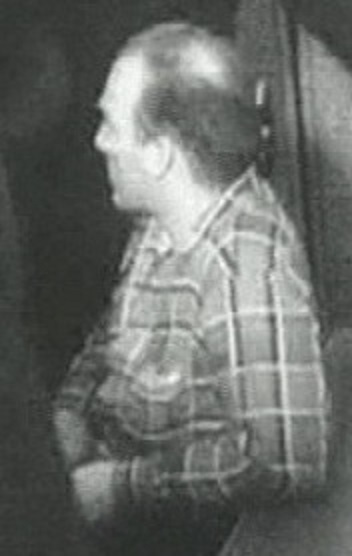
(2) Lovelady generates no reaction from anyone in the film. Cops were passing closely by him, yet none of them look at him or acknowledge him in any way. They were transferring the most high-value prisoner in the world at the time and suddenly, within their midst, was another man, a stranger to them, a warehouse worker who was sitting at a police desk. But not one of them reacted to Lovelady. No one glanced at him. No one showed him the least bit of attention. No one was the least bit interested in him. They were not just disinterested, but totally unaware of him. They acted like he wasn't there. He wasn't. He was superimposed into the footage.
Let's expound on this a little. The way our vision works is that we have a visual field, and we have objects within the field. We focus on objects within the field. We discriminate about what we focus on. We "see" some things, and other things remain relatively out of focus and part of the background. Guess which objects stand out and attract our attention the most? Human objects: other people.
It's very unlikely that you would pass closely by someone in a room without giving him or her at least a quick glance, even if it's only for a split-second. After all, it might be a pretty girl, right? And especially when someone is practically in contact with you in your personal space, you would visually sync on him for a split-second. Who knows, it could be a guy with a knife waiting to stab you, right? By reflex alone, these cops would have glanced at Lovelady, if only for a split-second, in passing by him so closely, but none of them do.
But wait! These were cops, police officers. Cops are trained to be observant. Cops are trained to pay attention to their surroundings. Cops are also trained to ask questions, such as, "Who are you? What are you doing here?" Isn't it incredible that not one of these trained officers synced on Lovelady, especially when they were passing by him so closely?
(3) The physical logistics of getting by Lovelady would have been very awkward and difficult in that small, cramped space. It was a very narrow lane. Lovelady was supposedly sitting there, and his feet and his legs were extending out into the walkway. His chair wasn't facing the desk; it was facing into the lane. It would have been cumbersome for anyone to get by him, never mine two who were side by side.
And Lovelady had to know that they were approaching because they were like a herd, a procession. Realizing that he was in the way, wouldn't he have gotten up and moved out of the way? Don't we all tend to move out of the way of the police?
What was he even doing there in that deep cubby-hole of the Homicide detectives? This was their squad room, their locker room, their inner sanctum. He was a warehouse worker, one of a group brought to City Hall from Dealey Plaza to make statements. Why separate him out from the rest? There was nothing special about him.
Below is the schematic of the 3rd floor of the Dallas PD. Oswald was led into the Homicide and Robbery Bureau. The X marks the spot where Lovelady's desk was, and it is the only place it could have been. We know it was against a wall on the right, with a door beyond the desk, and then a wall beyond the door. There is no other place within the Homicide and Robbery Bureau that fits this model.
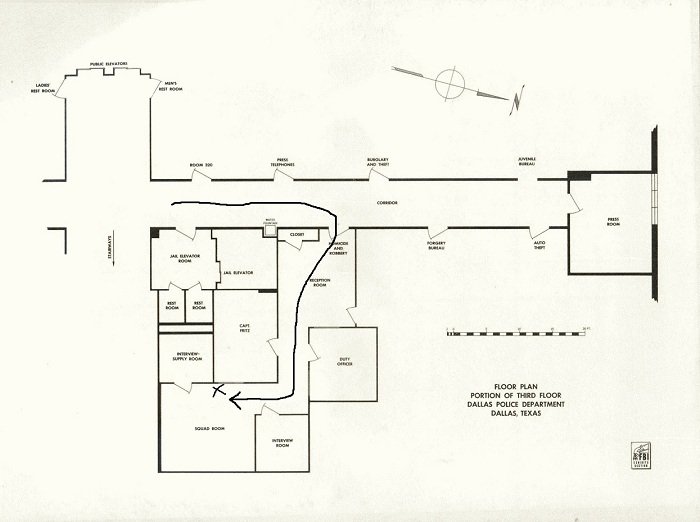
It was the inner sanctum of the Homicide detectives. What was Lovelady doing there? Where was the rest of the group from Dealey Plaza brought in to make statements? Obviously, not in that tiny Squad room. Would the police have marched them deep into the bowels of the PD just to make statements? And why seat him at a police desk that was right in the lane of traffic? And why separate Lovelady out from the others? The truth is that nothing makes sense about Lovelady being perched in that spot.
But, here is the biggest sticking point: Oswald and the uniformed cop were walking double-file, so it would have been twice as hard for them to get by Lovelady. So, how did they manage it? Including Billy, that would have been three across. They definitely could not have passed him without making an adjustment: going around him, stepping over his feet, or waiting for him to twist out of the way. Something had to happen. So how did it go down?
We don't know. The movie doesn't show it. From the moment it starts, the uniformed cop and Oswald are already past Lovelady. See for yourself. This is from David Wolper's Four Days in November. Notice that the action of this clip is to get Oswald to Fritz' door. They were delivering Oswald to Fritz.
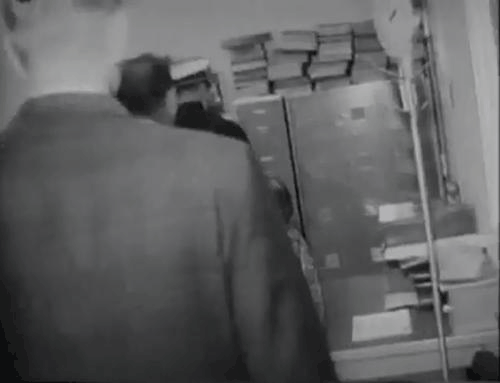
Notice that we first see Lovelady in profile and then he starts turning right. He never turns left. He is following the action to Fritz' door.
But, the story is very different in the DeNiro version. This DeNiro version is from Three Shots That Changed America by the History Channel, seen below. It's a very different take on the same tall tale.
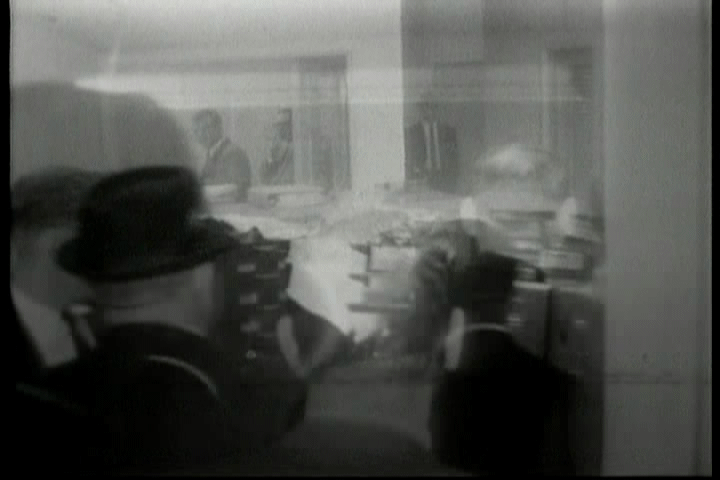
Notice that it consists of three sections:
1. the procession trudging along in a drab, dark way- we see the backs of their heads
2. the revealing of DeNiro Lovelady, including some very clear, crisp frames of him
3. then the linebacker-cop moves in the way; then it breaks to a newscaster.
And that's it. We never see Oswald being delivered to Fritz' office, as we saw in Four Days in November--which was the purpose of the whole trek. Look again at the top one, and you'll see the uniformed cop and Oswald turning right and approaching Fritz' door, and Lovelady following the action. We don't see Fritz, but we presume the cop was looking for him.
So, it means that in the DeNiro version, they cut out the most important part- the delivery of Oswald to Fritz' door. They kept the part with the cops trudging along, but they cut out the part where Oswald reaches his destination. What sense is there in that? What sense is there in having to "edit" a 4 second clip at all? But, if you were going to edit it, wouldn't you keep the most important part and get rid of the dull trudging along by the cops?
But, it's easy to understand why they couldn't show the delivery of Oswald to Fritz' door. It's because it was a re-enactment. Notice that in the Wolper film, you can see some of the face of the uniformed cop when he turns right. But, they didn't have him for the re-enactment. It was somebody else. They were all somebody elses. The only face you see in the re-enactment is that of DeNiro, who was an actor. He was fake, but I guess they felt he looked enough like Lovelady to get away with it. But, they weren't going to try to match the face of the uniformed cop. Plus, the didn't have Oswald, so they could not show his face either. And that's why they had to ditch the part about them turning right- because they couldn't show their faces--neither the cop's nor Oswald's.
But, the fact is: they didn't care about showing Oswald being delivered to Fritz. Lovelady was the star of this show- not Oswald. They just wanted to show Lovelady wearing that plaid shirt. That was the whole purpose of the clip- nothing more. This was all about showing Lovelady in a plaid shirt. They didn't start making these phony films until Harold Weisberg started screaming that Lovelady actually wore a striped shirt that day, which was short-sleeved, which meant that he couldn't be Doorman. And that's why concocting these phony images of Lovelady wearing a plaid shirt became necessary.
Notice also that in the DeNiro version, Lovelady is turned left, that is, towards us. They did that so that we could get a good look at him. They were feeling cocky about how much he looked like Lovelady. But, in the Wolper version, Lovelady is never turned left. He starts off in profile and then immediately starts turning right- away from us. Embedded Lovelady never turns left but does turn right, while DeNiro Lovelady never turns right but is always turned left. So, they were not only different men but they were performing different actions.
But, there is also a version that strings DeNiro Lovelady and Embedded Lovelady together in succession. And here it is below, from A Year Ago Today by WFAA television. And what it consists of is:
1. the dark, drab procession of the cops and Oswald, but it's shorter
2. a glimpse of DeNiro Lovelady, but it's very brief and very blurred.
3. the linebacker-cop gets in the way, blocking the screen
4. when he moves aside, we see Lovelady again, but it's Embedded Lovelady
5. then we see Oswald being delivered to Fritz' door.
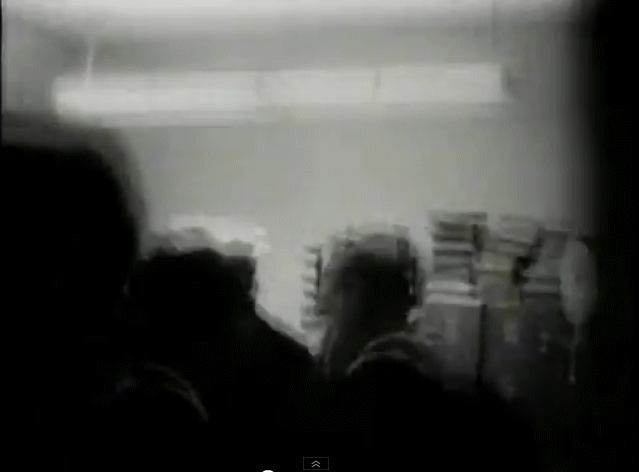
Isn't it obvious that this is just the stringing together of the other two? Notice that they had to blur DeNiro Lovelady an awful lot and show him for only a split-second in order to sell this thing. It was a classic bait and switch. And, if you look closely, you can see that DeNiro looks a lot thinner. He's no longer that big, beefy guy from before. We'll have more to say about that in a moment.
Notice also how jerking and jarring the whole thing is. It almost gives you a headache to watch it. Obviously, it was patched together, spliced together, and rather crudely. Did they really think they were going to get away with this?
The transitional frames are shown below. Look at them closely, and you will see that first it's DeNiro Lovelady, then this big linebacker-cop gets in the way blocking the screen, and then when he moves aside, it's Embedded Lovelady for the rest of the clip.
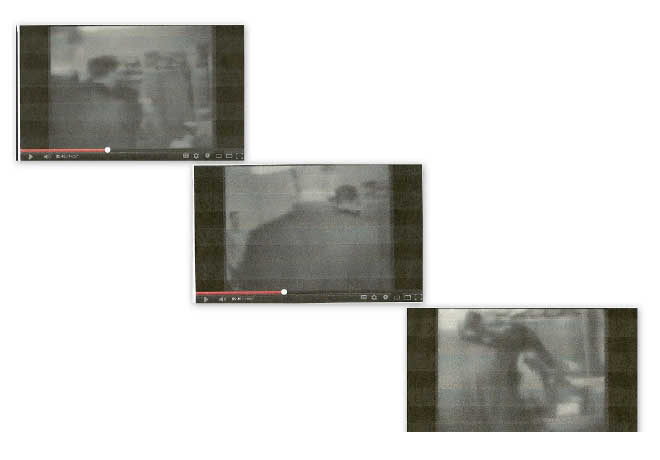
For a complete analysis of the three versions of the Dallas PD footage, see “JFK Special 5: Oswald was in the doorway, after all”, http://www.veteranstoday.com/2012/06/12/jfk-special-5-oswald-was-in-the-doorway-after-all/
Richard Hooke created a collage of Lovelady: the real and the fanciful:
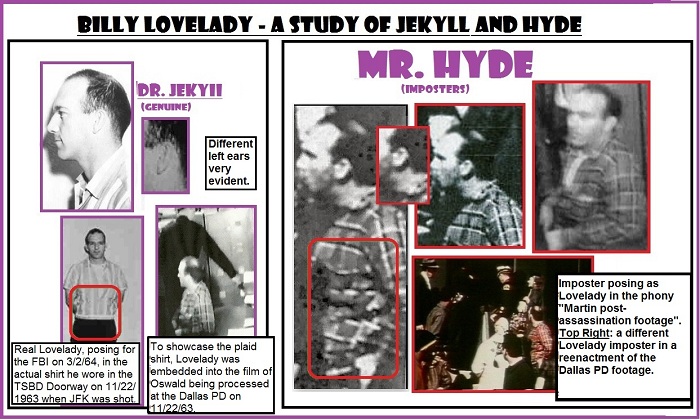
Second, doesn't the man on the right look quite a bit stockier? Don't you have the sense that he is quite a lot heavier? We never had that sense when comparing Doorman to Oswald, where they always seemed to be the same size and the same build.
Third, when you compare the shirt patterns, both look "varied" and "complex" but they are certainly not identical. This isn't horseshoes or hand grenades, so close doesn't count. Furthermore, we now know that the splotchyness of Doorman's shirt is due to haze and distortion. That's all it is. Without that, his shirt just looks grainy. And notice that Gorilla Lovelady has pattern all the way up to and including his collar. Now look at Doorman's upper right side (on our left). Doesn't it just look bland and grainy, like Oswald's? In no version of the Altgens photo does Doorman's shirt look checkered. Checkered means horizontal and vertical lines crossing and forming boxes. Gorilla Lovelady's shirt is strewn with boxes; there is not a single box on Doorman's shirt.
Fourth, look at the left side of Doorman's shirt on our right, the margin of it. Doesn't it look thicker and more substantial than the flimsy margin on the other side? Doesn't it look about twice as thick? It was twice as thick, as it was folded over into a long lapel on that side. But now look at Gorilla Lovelady. Do you see a lapel on him? No, it just a regular shirt with a regular collar and the standard lay. But, Doorman's shirt looks more like what we saw on Oswald with the long jacket-like fold down the left side.
Fifth, doesn't Doorman's face have a rather soft look, whereas Gorilla Lovelady's has a very hard look? Granted, those are subjective qualities, but still, they are discernible. The guy on the right looks like a caveman; the guy on the left does not. Both visually in terms of specifics, and intuitively in terms of the general impression, these two look like vastly different men.
So, where did Gorilla Man come from? They stuck him in there. It was a video merger, a technological trick. Was it possible in 1966? Most definitely. They were doing video mergers as early at 1945. Check out the movie Anchors Aweigh with Gene Kelly.
Now let's also compare Gorilla Lovelady, supposedly from the Martin film, to Hughes Lovelady, which was another film. It was supposed to be the same man at the exact same moment in time and space. Whoops! In one, his shirt is cinched up, and in the other, it is sprawled open. It's easy to lose track of details when you are making phony movies.

You should take a close look at that Hughes Lovelady above on the right. Do you notice that he looks like a cartoon? Yet, they actually claim that he is a photographic image. And notice that his shirt does not look plaid, rather, it looks geometric with large blocks and wedges in red, black, and white. Why is that? There is a simple explanation, although it eluded me for years. It's because that figure from the Hughes film was implanted, and for the first second or two, it was an unstable, distorted image, and that is what we are seeing. And apparently, someone went ahead and photoshopped that distorted image. And they went ahead and gave him a ridiculous Mohawk hairstyle as well. Again: people actually point to that figure as an example of Billy Lovelady on 11/22/63 from the Hughes film, even though he looks more like a cartoon than a photograph. Below, there is another example of it. He looks nothing like the real Lovelady, nor does he look anything like the Altgens Doorman. He doesn't even look human; he looks like a freak.

Eventually, his image settled down to what you see below, which looks relatively normal, having lost the freaky aspects. But, it still isn't Lovelady. You can be absolutely certain that he is not Billy Lovelady, and he does not look remotely like him. He is a photographic fraud.

Now, let's look at another movie, supposedly of Lovelady, from 22 November 1963. This film was taken at the Dallas Police Department (DPD) where Lovelady was waiting to make a statement. Supposedly, he was sitting at a work-desk in the squad room of the Homicide detectives (their inner sanctum) as Lee Harvey Oswald was led by:

Does that look like the real Lovelady? Let's compare him to FBI Lovelady. He's got a much bigger head- a truly massive cranium- and he's got a heavier, more muscular build. He is indeed an imposter, although not the same imposter as Gorlla Lovelady. Look at them both and compare them both to FBI Lovelady.

They are three different men. Putting it brusquely, in the middle is the real Billy Lovelady from his FBI photoshoot; on the left is a beefier guy with a face like Robert DeNiro; and on the right is a guy who looks like a Neanderthal caveman. They are all supposed to be Billy Lovelady, but only the middle one is.
But, a further problem with the DPD film is that there are at least two versions of it, where in the other version, yet another guy appears as Lovelady. Here are the two different Loveladys, side by side, from the two different versions of the squad room scene:

The Lovelady on the left we refer to as DeNiro Lovelady because he reminds Ralph of a young Robert DeNiro, although with a thicker, heavier build. We don't know who the Lovelady on the right is, except that he is a different man. Do you notice how much stockier DeNiro Lovelady is? He has got to weigh at least 30 pounds more than the other guy, and that is being conservative. Look at his massive arm. Look how DeNiro's shirt is spread open in a weird rectangular way, while the other guy's shirt is not. Look at the different direction of their hair: DeNiro's is combed straight back, while the other's is parted and combed over from the left to right. It's supposed to be the same man at the same moment in time and space. Look at the larger head on DeNiro and the greater depth to his head. These are different men. And yet, they are supposed to be the same man, the same situation, the same second. Are you buying it? They are even turned oppositely. The Lovelady on the right was done first, sometime in the 1970s. The other Lovelady on the left was done much later, possibly in the 21st century, and it was meant to be a vast improvement over the first. And, it involved a reenactment. Essentially, they added him and replaced everybody else as well but kept the background of the room. They went to a lot of trouble. In the first version, they just installed the Lovelady figure and that's all.

Here are the reasons why we believe the Lovelady figure above was embedded into the film. (1) In the movie, Lovelady, at times, has a white glow, where his lighting is strange and different. He seems to be illuminated, and he almost looks like a cartoon character. You can see an example of it in the image above. Do you see how white he looks? Not all the frames of him are like that, but some of them are. He was implanted. Even by 1964, the technology existed to do this. That's when the film Mary Poppins came out, so the technology to embed one video into another existed. Here are some examples from that film:

We also notice that, in Youtube versions, this Lovelady tends to bleed. Look again at the image above the cartoons and you can see the black bleed along the bottom of his forearm and behind his shoulder. Below is another frame in which his hair bleeds back creating a ducktail effect.

Isn't that weird? It almost looks painted on with a brush. That, no doubt, is distortion, but you see such distortions frequently on him, but you don't see such distortions on anyone else- only on him. Apparently, the constitution of the superimposed image is unstable and does not hold up well in a digital environment.
Here is another interesting proof that this Lovelady is fake. Look at the position of his arms. His left elbow is resting on the table. At first glance, it looks like his right elbow is doing the same, but look closely: it's miles away from the table. He can't be resting it on the table, and there's nothing else there to support it.

The next floor down for his right arm is his lap, but if he were resting it on his lap, that would shift the whole axis of his body. We'd see him listing to the right. But, he's not listing right. His head is turned a little to the right, but not his body. His body looks perfectly upright with no sinking down on the right. And his hands are close together. The positions of his arms look balanced and symmetrical. His shoulders seem even; although we are surmising that since we can't see his right. Could he just be holding his right elbow in space at the same level as the table? No, that's out of the question. Nobody does that. It's a lot of work to do that. It creates a lot of tension to do that. And he had no reason to do it. What it looks like is that he was sitting somewhere with both elbows propped up on something, but it wasn't that table. It may have been another table in another spot--wherever they shot the original footage. In this footage, his right elbow seems to be levitating in space. And one more thing: he's too old. Look at this guy. Does he look like a 26 year old? That's how old Billy Lovelady was at the time.

(2) Lovelady generates no reaction from anyone in the film. Cops were passing closely by him, yet none of them look at him or acknowledge him in any way. They were transferring the most high-value prisoner in the world at the time and suddenly, within their midst, was another man, a stranger to them, a warehouse worker who was sitting at a police desk. But not one of them reacted to Lovelady. No one glanced at him. No one showed him the least bit of attention. No one was the least bit interested in him. They were not just disinterested, but totally unaware of him. They acted like he wasn't there. He wasn't. He was superimposed into the footage.
Let's expound on this a little. The way our vision works is that we have a visual field, and we have objects within the field. We focus on objects within the field. We discriminate about what we focus on. We "see" some things, and other things remain relatively out of focus and part of the background. Guess which objects stand out and attract our attention the most? Human objects: other people.
It's very unlikely that you would pass closely by someone in a room without giving him or her at least a quick glance, even if it's only for a split-second. After all, it might be a pretty girl, right? And especially when someone is practically in contact with you in your personal space, you would visually sync on him for a split-second. Who knows, it could be a guy with a knife waiting to stab you, right? By reflex alone, these cops would have glanced at Lovelady, if only for a split-second, in passing by him so closely, but none of them do.
But wait! These were cops, police officers. Cops are trained to be observant. Cops are trained to pay attention to their surroundings. Cops are also trained to ask questions, such as, "Who are you? What are you doing here?" Isn't it incredible that not one of these trained officers synced on Lovelady, especially when they were passing by him so closely?
(3) The physical logistics of getting by Lovelady would have been very awkward and difficult in that small, cramped space. It was a very narrow lane. Lovelady was supposedly sitting there, and his feet and his legs were extending out into the walkway. His chair wasn't facing the desk; it was facing into the lane. It would have been cumbersome for anyone to get by him, never mine two who were side by side.
And Lovelady had to know that they were approaching because they were like a herd, a procession. Realizing that he was in the way, wouldn't he have gotten up and moved out of the way? Don't we all tend to move out of the way of the police?
What was he even doing there in that deep cubby-hole of the Homicide detectives? This was their squad room, their locker room, their inner sanctum. He was a warehouse worker, one of a group brought to City Hall from Dealey Plaza to make statements. Why separate him out from the rest? There was nothing special about him.
Below is the schematic of the 3rd floor of the Dallas PD. Oswald was led into the Homicide and Robbery Bureau. The X marks the spot where Lovelady's desk was, and it is the only place it could have been. We know it was against a wall on the right, with a door beyond the desk, and then a wall beyond the door. There is no other place within the Homicide and Robbery Bureau that fits this model.

It was the inner sanctum of the Homicide detectives. What was Lovelady doing there? Where was the rest of the group from Dealey Plaza brought in to make statements? Obviously, not in that tiny Squad room. Would the police have marched them deep into the bowels of the PD just to make statements? And why seat him at a police desk that was right in the lane of traffic? And why separate Lovelady out from the others? The truth is that nothing makes sense about Lovelady being perched in that spot.
But, here is the biggest sticking point: Oswald and the uniformed cop were walking double-file, so it would have been twice as hard for them to get by Lovelady. So, how did they manage it? Including Billy, that would have been three across. They definitely could not have passed him without making an adjustment: going around him, stepping over his feet, or waiting for him to twist out of the way. Something had to happen. So how did it go down?
We don't know. The movie doesn't show it. From the moment it starts, the uniformed cop and Oswald are already past Lovelady. See for yourself. This is from David Wolper's Four Days in November. Notice that the action of this clip is to get Oswald to Fritz' door. They were delivering Oswald to Fritz.

Notice that we first see Lovelady in profile and then he starts turning right. He never turns left. He is following the action to Fritz' door.
But, the story is very different in the DeNiro version. This DeNiro version is from Three Shots That Changed America by the History Channel, seen below. It's a very different take on the same tall tale.

Notice that it consists of three sections:
1. the procession trudging along in a drab, dark way- we see the backs of their heads
2. the revealing of DeNiro Lovelady, including some very clear, crisp frames of him
3. then the linebacker-cop moves in the way; then it breaks to a newscaster.
And that's it. We never see Oswald being delivered to Fritz' office, as we saw in Four Days in November--which was the purpose of the whole trek. Look again at the top one, and you'll see the uniformed cop and Oswald turning right and approaching Fritz' door, and Lovelady following the action. We don't see Fritz, but we presume the cop was looking for him.
So, it means that in the DeNiro version, they cut out the most important part- the delivery of Oswald to Fritz' door. They kept the part with the cops trudging along, but they cut out the part where Oswald reaches his destination. What sense is there in that? What sense is there in having to "edit" a 4 second clip at all? But, if you were going to edit it, wouldn't you keep the most important part and get rid of the dull trudging along by the cops?
But, it's easy to understand why they couldn't show the delivery of Oswald to Fritz' door. It's because it was a re-enactment. Notice that in the Wolper film, you can see some of the face of the uniformed cop when he turns right. But, they didn't have him for the re-enactment. It was somebody else. They were all somebody elses. The only face you see in the re-enactment is that of DeNiro, who was an actor. He was fake, but I guess they felt he looked enough like Lovelady to get away with it. But, they weren't going to try to match the face of the uniformed cop. Plus, the didn't have Oswald, so they could not show his face either. And that's why they had to ditch the part about them turning right- because they couldn't show their faces--neither the cop's nor Oswald's.
But, the fact is: they didn't care about showing Oswald being delivered to Fritz. Lovelady was the star of this show- not Oswald. They just wanted to show Lovelady wearing that plaid shirt. That was the whole purpose of the clip- nothing more. This was all about showing Lovelady in a plaid shirt. They didn't start making these phony films until Harold Weisberg started screaming that Lovelady actually wore a striped shirt that day, which was short-sleeved, which meant that he couldn't be Doorman. And that's why concocting these phony images of Lovelady wearing a plaid shirt became necessary.
Notice also that in the DeNiro version, Lovelady is turned left, that is, towards us. They did that so that we could get a good look at him. They were feeling cocky about how much he looked like Lovelady. But, in the Wolper version, Lovelady is never turned left. He starts off in profile and then immediately starts turning right- away from us. Embedded Lovelady never turns left but does turn right, while DeNiro Lovelady never turns right but is always turned left. So, they were not only different men but they were performing different actions.
But, there is also a version that strings DeNiro Lovelady and Embedded Lovelady together in succession. And here it is below, from A Year Ago Today by WFAA television. And what it consists of is:
1. the dark, drab procession of the cops and Oswald, but it's shorter
2. a glimpse of DeNiro Lovelady, but it's very brief and very blurred.
3. the linebacker-cop gets in the way, blocking the screen
4. when he moves aside, we see Lovelady again, but it's Embedded Lovelady
5. then we see Oswald being delivered to Fritz' door.

Isn't it obvious that this is just the stringing together of the other two? Notice that they had to blur DeNiro Lovelady an awful lot and show him for only a split-second in order to sell this thing. It was a classic bait and switch. And, if you look closely, you can see that DeNiro looks a lot thinner. He's no longer that big, beefy guy from before. We'll have more to say about that in a moment.
Notice also how jerking and jarring the whole thing is. It almost gives you a headache to watch it. Obviously, it was patched together, spliced together, and rather crudely. Did they really think they were going to get away with this?
The transitional frames are shown below. Look at them closely, and you will see that first it's DeNiro Lovelady, then this big linebacker-cop gets in the way blocking the screen, and then when he moves aside, it's Embedded Lovelady for the rest of the clip.

For a complete analysis of the three versions of the Dallas PD footage, see “JFK Special 5: Oswald was in the doorway, after all”, http://www.veteranstoday.com/2012/06/12/jfk-special-5-oswald-was-in-the-doorway-after-all/
Richard Hooke created a collage of Lovelady: the real and the fanciful:

Remember: the embedding of Embedded Lovelady into the real footage came first. But, they became dissatisfied with it, and the reenactment with DeNiro Lovelady was made much later. The DeNiro clip appears in the History Channel's JFK:Three Shots That Changed America which was broadcast in 2009. There is neither hide nor hair of Embedded Lovelady in that film. They must have felt a pressing need to improve upon their original fraud.
To give you an idea how Machieavellian the forces are that are organized to suppress JFK truth, look at what they did recently. Recall that DeNiro Lovelady appears to be at least 30 pounds heavier than Embedded Lovelady, and it really jumps out at you. What they did was remove the original Three Shots That Changed America film from Youtube, by order of the History Channel, and they replaced it with a version in which DeNiro looks much thinner. Take a look.
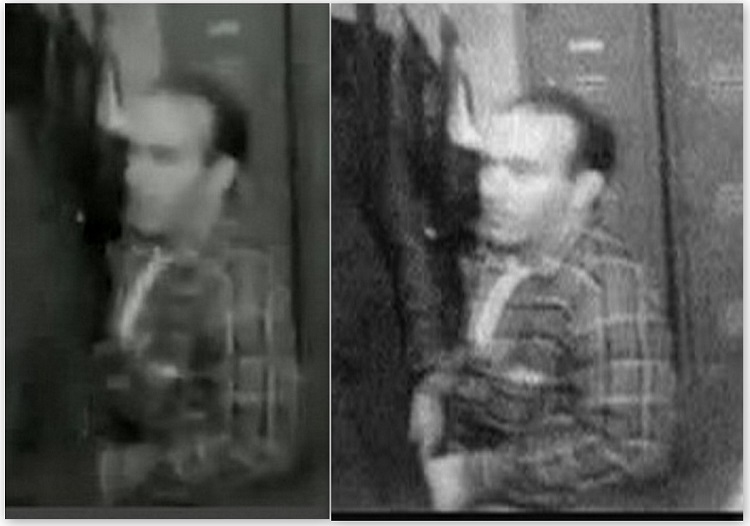
Isn't that amazing? Look how thin he looks! Did he join Weight Watchers? Or was it Jenny Craig? Look how they had to distort the image in order to pare him down. Look how narrow the lockers look. They look more like children's lockers than police lockers. The whole image on the left looks freaky. It's startling what they thought they could get away with, as if no one would notice.
Oswald never passed Lovelady in the squad room; it is just a big lie. And if you have any doubt about it, just consider what Lovelady told the Warren Commission.
Mr. BALL - You were on the west elevator?
Mr. LOVELADY - Right.
Mr. BALL - Oswald was standing in front of the east elevator?
Mr. LOVELADY - East, on back, the elevator back.
Mr. BALL - Did you see him?
Mr. LOVELADY - No; I didn't; I just heard his voice because---where those slats are in back of the elevator.
Mr. BALL - Did you ever see him again that day?
Mr. LOVELADY - No.
As the years passed, Lovelady was being posed for the camera repeatedly while wearing a plaid shirt, presumably the same shirt he wore on 22 November 1963.
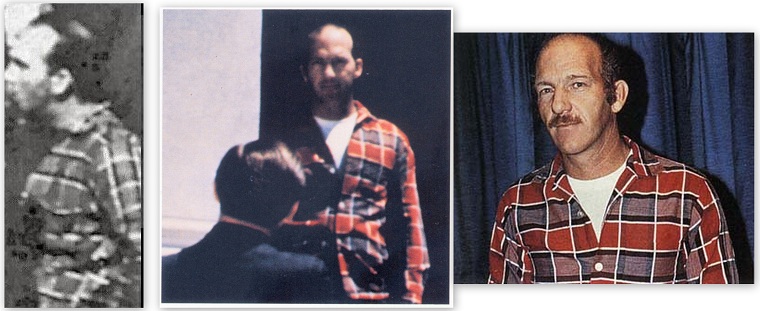
Notice the pocket with a big pocket-flap on TSBD Lovelady on the left. There is definitely no pocket-flap on the shirts of '71 Lovelady in the middle taken by Robert Jackson, nor on '76 Lovelady on the right, taken by Robert Groden. Look closely and get out a magnifying glass if you have to. There may be a pocket, but there is definitely no pocket-flap on either of them. It was not the same shirt, and it was not the same man. Lovelady on the left was an imposter.
To give you an idea how Machieavellian the forces are that are organized to suppress JFK truth, look at what they did recently. Recall that DeNiro Lovelady appears to be at least 30 pounds heavier than Embedded Lovelady, and it really jumps out at you. What they did was remove the original Three Shots That Changed America film from Youtube, by order of the History Channel, and they replaced it with a version in which DeNiro looks much thinner. Take a look.

Isn't that amazing? Look how thin he looks! Did he join Weight Watchers? Or was it Jenny Craig? Look how they had to distort the image in order to pare him down. Look how narrow the lockers look. They look more like children's lockers than police lockers. The whole image on the left looks freaky. It's startling what they thought they could get away with, as if no one would notice.
Oswald never passed Lovelady in the squad room; it is just a big lie. And if you have any doubt about it, just consider what Lovelady told the Warren Commission.
Mr. BALL - You were on the west elevator?
Mr. LOVELADY - Right.
Mr. BALL - Oswald was standing in front of the east elevator?
Mr. LOVELADY - East, on back, the elevator back.
Mr. BALL - Did you see him?
Mr. LOVELADY - No; I didn't; I just heard his voice because---where those slats are in back of the elevator.
Mr. BALL - Did you ever see him again that day?
Mr. LOVELADY - No.
As the years passed, Lovelady was being posed for the camera repeatedly while wearing a plaid shirt, presumably the same shirt he wore on 22 November 1963.

Notice the pocket with a big pocket-flap on TSBD Lovelady on the left. There is definitely no pocket-flap on the shirts of '71 Lovelady in the middle taken by Robert Jackson, nor on '76 Lovelady on the right, taken by Robert Groden. Look closely and get out a magnifying glass if you have to. There may be a pocket, but there is definitely no pocket-flap on either of them. It was not the same shirt, and it was not the same man. Lovelady on the left was an imposter.
It is known that Lovelady lost a lot of weight after the assassination. He was not 170 pounds any more, which is especially obvious in his last photo on the right. So, how did the same shirt continue to fit him so snugly? What, did it shrink in the wash?
Be aware that the shirt pattern is the only characteristic of the clothing that has ever been matched to Lovelady, but it is also bogus. Compare these patterns:
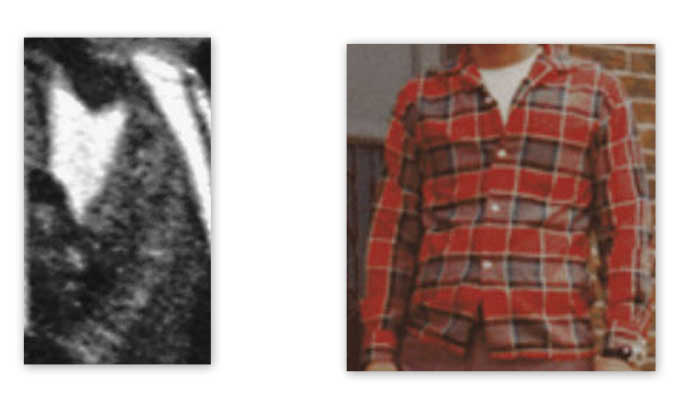
They are both varied, but they are not the same pattern. Doorman's shirt looks splotchy but not chequed like Lovelady's. Plaid means horizontal and vertical lines crossing and forming boxes, but we don't see a single instance of that on Doorman's shirt. On its upper right side, Doorman's shirt has no pattern at all except for graininess, in contrast to Lovelady's complex geometric pattern. Lovelady's shirt is strewn with boxes, but there is not a single box on Doorman's shirt. So, how can they be the same shirt? On the right, which is Lovelady from 1976, look at the cuff where the white lines form a cross. But, on Doorman's cuff, the white lines are parallel, like railroad tracks. This isn't horseshoes or hand grenades. Close isn't good enough, but these aren't even close. They were different shirts and therefore different men.
It is unclear when Lovelady first started claiming to be Doorman. One report has it that he claimed it the very next day after the assassination when the FBI showed up at his house with a giant blowup of Doorman. But, that wasn't Lovelady talking; that was the FBI talking. Why didn't they sit him down in front of a sea of microphones to declare that he was Doorman? It's very clear from the historical record that Lovelady didn't like talking about it. He eventually went along with the ruse, but he was not comfortable doing it. And who can blame him? How would you like to carry on a colossal lie for the rest of your life?
At the time of his Warren Commission testimony, Billy hadn't started lying yet. He claimed to be at the top of the steps, and presumably, he drew an arrow pointing to Doorman to identify himself in the picture. But, did he really?
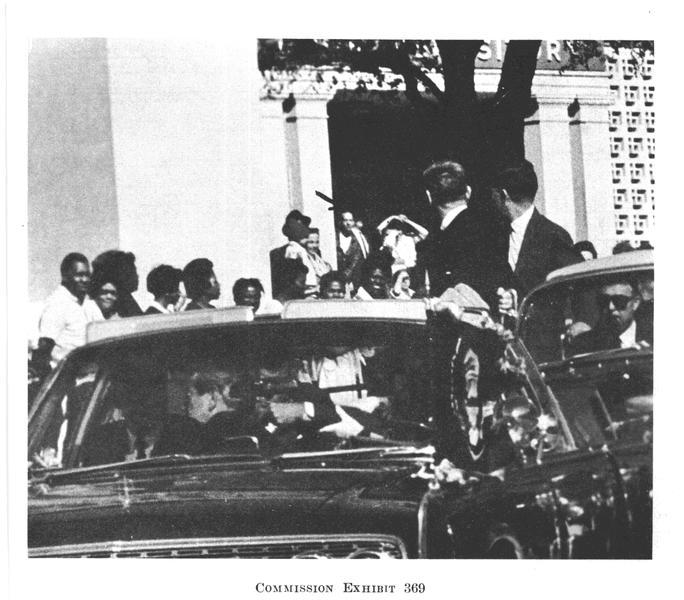
You see that big arrow, right? Well, we know now that that large visible arrow is Frazier's arrow, not Lovelady's. Frazier's was drawn in the white, as that one mostly is. Lovelady's was drawn in the black. So, where is Lovelady's? Mystery surrounds it. It's strange enough that the exact same exhibit- Exhibit 369 - was used for both of them to draw on. More WC flim-flam in Ralph's opinion. Why not let each of them mark a separate photo? Wouldn't that have been the unbiased way to do it? Here are their testimonies, first Frazier from March 11, 1964, and then Lovelady from April 7, 1964.
Mr. BALL - We have got a picture taken the day of the parade and it shows the President's car going by. Now, take a look at that picture. Can you see your picture any place there?
Mr. FRAZIER - No, sir; I don't, because I was back up in this more or less black area here.
Mr. BALL - I see.
Mr. FRAZIER - Because Billy, like I say, is two or three steps down in front of me.
Mr. BALL - Do you recognize this fellow?
Mr. FRAZIER - That is Billy, that is Billy Lovelady.
Mr. BALL - Billy?
Mr. FRAZIER - Right
Mr. BALL - Let's take a marker and make an arrow down that way. That mark is Billy Lovelady?
Mr. FRAZIER - Right.
Mr. BALL - That is where you told us you were standing a moment ago.
Mr. FRAZIER - Right.
Mr. BALL - In front of you to the right over to the wall?
Mr. FRAZIER - Yes.
Mr. BALL - Is this a Commission exhibit? We will make this a Commission Exhibit 369.
(The document referred to was marked Commission Exhibit No. 369 for identification.)
Mr. BALL - That is written in. The arrow marks Billy Lovelady on Commission Exhibit 369.
Mr. BALL - I have got a picture here, Commission Exhibit 369. Are you in that picture?
Mr. LOVELADY - Yes, sir.
Mr. BALL - Take a pen or pencil and mark an arrow where you are.
Mr. LOVELADY - Where I thought the shots are?
Mr. BALL - No; you in the picture.
Mr. LOVELADY - Oh, here (indicating).
Mr. BALL - Draw an arrow down to that; do it in the dark. You got an arrow in the dark and one in the white pointing toward you. Where were you when the picture was taken?
Mr. LOVELADY - Right there at the entrance of the building standing on the top step, would be here (indicating).
Mr. BALL - You were standing on which step?
Mr. LOVELADY - It would be your top level.
Mr. BALL - The top step you were standing there?
Mr. LOVELADY - Right.
How could Billy be "two or three steps down in front" of Frazier, according to Frazier, and also be "on your top level" according to Lovelady? They were referring to the same picture, the same moment in time.
But, the whole exchange is bizarre. Why didn't Mr. Ball begin by saying explicitly, "You'll notice there is already an arrow there, which was drawn by another witness. But, we want to know what you think. So, just ignore that arrow and draw another one to the image of yourself."
And since both Lovelady and Frazier presumably marked the same photo, why didn't they indicate whose arrow was whose? Maybe have them initial it? It is just weird and inexplicable that they would have had them both mark the same copy. Were they economizing? Trying to save money for the taxpayers? There is no valid excuse for this. Is Lovelady's arrow even there at all? Well, brace yourself because we believe it is:
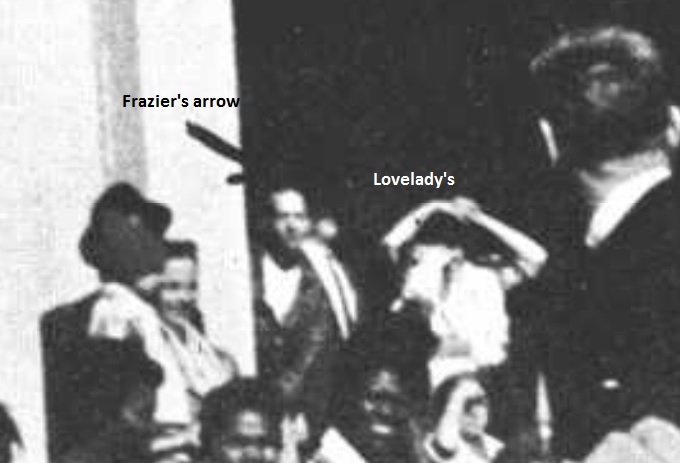
We believe that little mark on the forearm of Black Hole Man is the tail of Lovelady's arrow. The rest of it was, presumably, drawn in the dark space of the arms of Black Hole Man. If that is not part of Lovelady's arrow, then what is it, and how did it get there? It does not appear on any other version of the Altgens photo, only on C E 369. And, if it isn't Lovelady's arrow, where is Lovelady's arrow? It has to be there somewhere. So, that little mark wins by default for being the only other mark on the photo.
Here it is again up-close. If it seems vague and imperfect remember that Lovelady drew it very small, and this is an extreme blowup with all the distortion that that entails. Also, they may have done things to obscure it within the black space. The bottom line is that this is the only other thing that looks remotely like a deliberate mark on the photo besides Frazier's arrow.

Why did Lovelady draw his arrow so small? It's because he knew he wasn't giving Joseph Ball what he wanted, and he wanted to let him down easy. Joseph Ball was like the 800 pound gorilla, and you don't piss off an 800 pound gorilla any more than you have to. This was Lovelady's way of whispering to him: "Psst. This is me. I'm not the other guy. That was Oswald. But, don't worry; I'm not going to tell anybody. I just want to be left alone." Of course, Billy didn't get what he wanted.
I consider Lovelady's arrow on CE 369 to be the second most important image we have exonerating Oswald after Oswald in the doorway. Remember that we concluded that Black Hole Man was Lovelady BEFORE his arrow was discovered. Lovelady posed for the FBI on February 29, 1964 wearing the clothes he wore on November 22. In a letter to the Warren Commission, the FBI put it in writing that “Lovelady stated that he wore a red and white striped shirt and blue jeans.” And, he posed in that shirt with it substantially unbuttoned, just like Doorman. Why would he do that unless it was the same shirt that he wore? So, below we have Lovelady in the same outfit three times: once on February 29 and twice on November 22, as captured in the Couch film (center) and the Altgens photo (right).
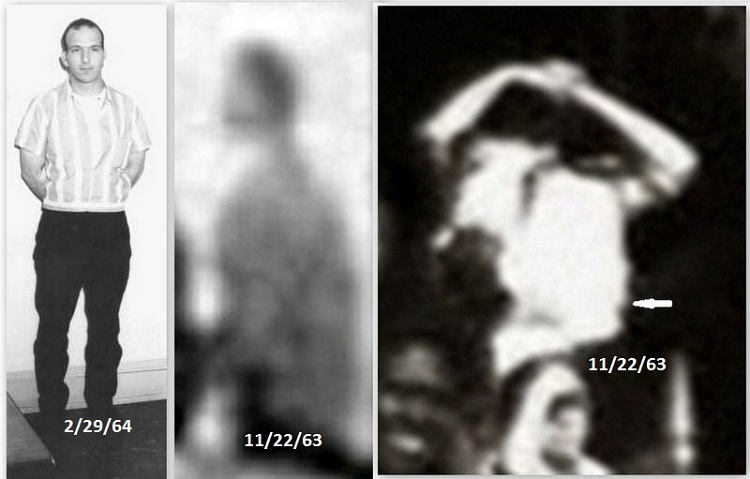
It would be an extraordinary coincidence if these were anything but the same man.
So, it appears that Billy Lovelady was trying to tell Joseph Ball that he was Black Hole Man, which is why Ball quickly changed the subject. But note that before making this discovery, we had already figured out that Lovelady was Black Hole Man- and the first researcher to come to that conclusion was Richard Hooke.
Billy's life changed tremendously after the assassination. Somehow, this lowly warehouse worker acquired the financial means to start his own trucking company in Denver. Wasn't that fortunate? Who says America isn't the land of opportunity? But then, his luck changed for the worse. Not long before the HSCA released its Final Report in 1979, he suffered a fatal first heart attack at the age of 41. Statistically, the odds of it happening were less than 1 in 10,000.
The bottom line is that there are no legitimate images of Billy Lovelady from 11/22/63. None. Every one of them is fake, meaning that they were impostors. We don't say that Lovelady impostors were there on 11/22/63, rather, they were added to the films later. The images taken by CBS in 1967 and Robert Groden in 1976 were really Lovelady, but they were doctored. The Mark Lane photo of Lovelady with the protruding ears is the only reliable, authentic image there is of him. It was an unauthorized photo taken by Mark Lane or a photographer in his employ, taken a few months after the assassination on a street in Dallas. Again: it is the only one for which we have complete confidence. Here are all three of those images, chronologically; the Mark Lane photo from 1964, the CBS photo from 1967, and the 1976 Robert Groden one.
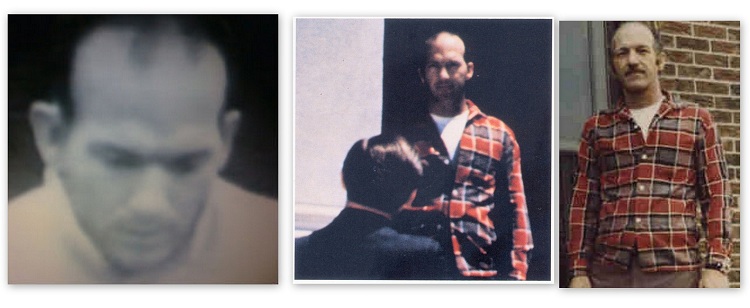
The image taken by Mark Lane on the left was taken right around the same time as the FBI photographs; it was the winter of 1964. But, look at them side by side below. Do you notice how much balder he looks in the image taken by Mark Lane on the left? We insist that they doctored Lovelady's hair in the FBI photos to match what they had done to Doorman, where they duplicated the hairline of Young Lovelady. They also got rid of his protruding ears. You know that something is wrong because these are supposed to be same man/same time.
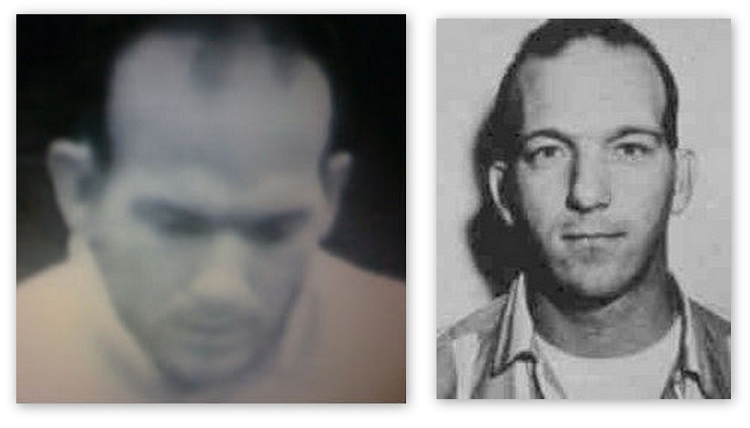
When you compare FBI Lovelady to Doorman, you see a pretty good match of their hairlines. But, it's nothing compared to the match between Young Lovelady and Doorman. Talk about matching hairlines! Wow! That's spot-on!
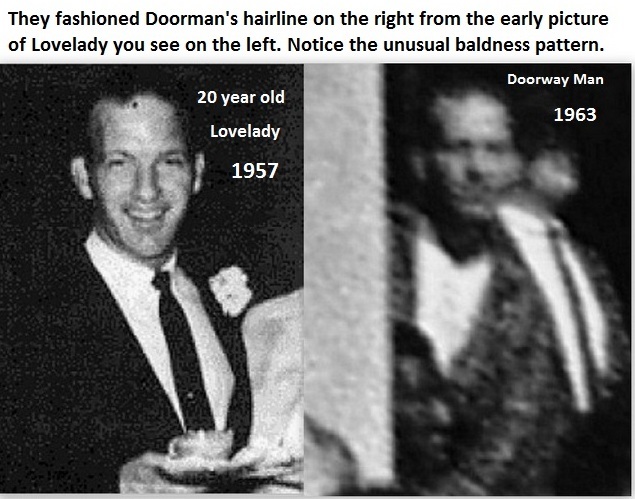
The photo on the left was taken in the 1950s, probably about 1957. Notice how his hairline matches Doorman's perfectly--to a tee. It's not just that the hairlines are the same, it's that the length of the hair, the lay of the hair, the twist of the hair, everything is the same. It's almost as if Billy had his hair a certain way back then, and then he didn't lie down or shower or do anything to change it for 7 years, and the length remained the same. It also meant that he didn't lose any hair in 7 years, even though 3 months later he would be practically bald. So, seemingly, his hair remained stable for 7 years and then fell out in droves. But, the truth is that young Billy underwent rapid balding, and his hairline did not remain stable for 7 years. It was just the opposite. It's apparent that they altered Doorman's hairline to match young Billy's. Why did they use an early picture of him? It was probably because they did not have a current one, and they did not realize how much hair he had lost.
And, after they put in the fix, they flipped the image of Young Lovelady to conceal what they had done. The flipped version is the only one that you can find online, and it is the one published in the HSCA Final Report which came out in January 1979. Compare them below. Flipped is on the left, and real is on the right. We had to unflip the flipped one.
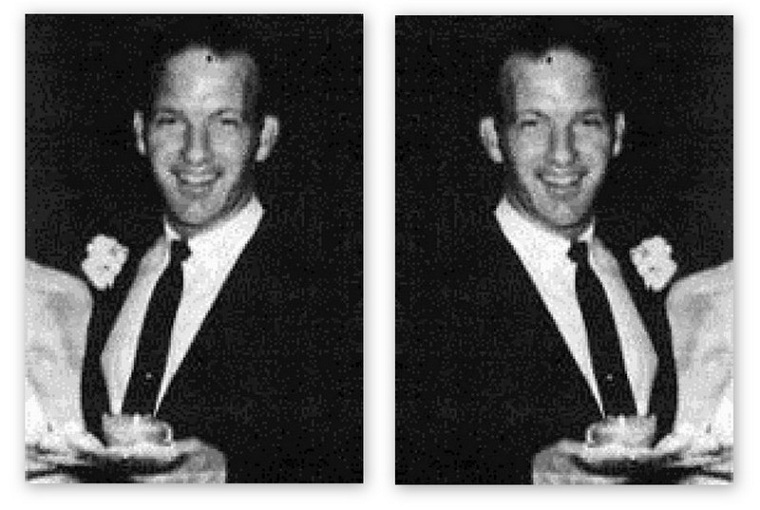
So, it started with the hairline of Young Lovelady, and Doorman's hairline was matched to it. Then, the FBI photo of Lovelady from 29 February 1964 was altered to match what they had done to Doorman. Oh, what a tangled web they weaved . . . Below are two fake hairlines.
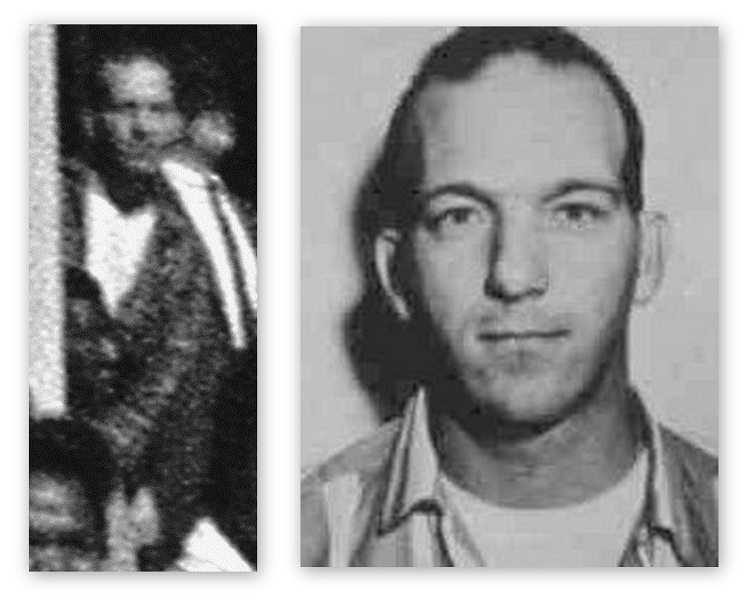
So, both hairlines above were matched to Young Lovelady's. But again, that would have meant 7 years of stable hair for Billy, which was impossible, as he underwent rapid, early, and severe balding. Doorman's hair actually matches Young Lovelady's the best. Conclusion: they used the image of Young Lovelady to create Doorman's hairline.
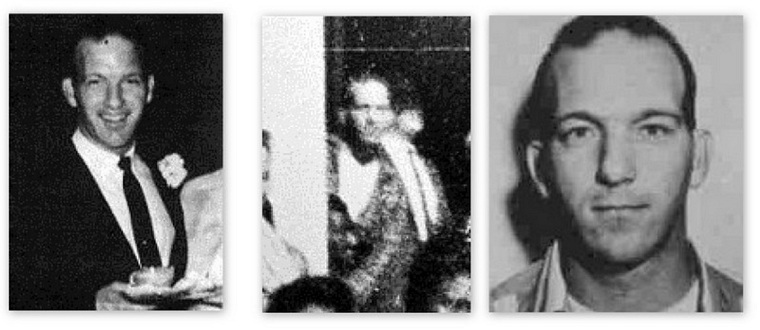
Another image of Billy Lovelady appears in the book, Forgive My Grief, Volume IV by Penn Jones. It's in the back of the back, adjacent to the inside back cover and it's similar to the picture in Mark Lane's Rush to Judgment. If anything, it's better because it shows his head and his hair completely. This is our best view of the real Billy Lovelady from the time of the assassination.
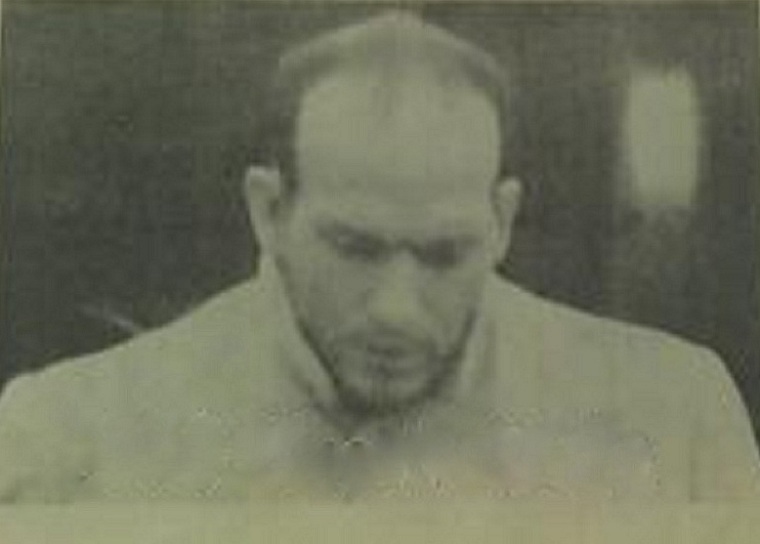
Again, notice how Lovelady's hair compares to Doorman's. Once more, it is clear that Doorman has Lovelady's hairline from a bygone era. No way was that his look in 1963.
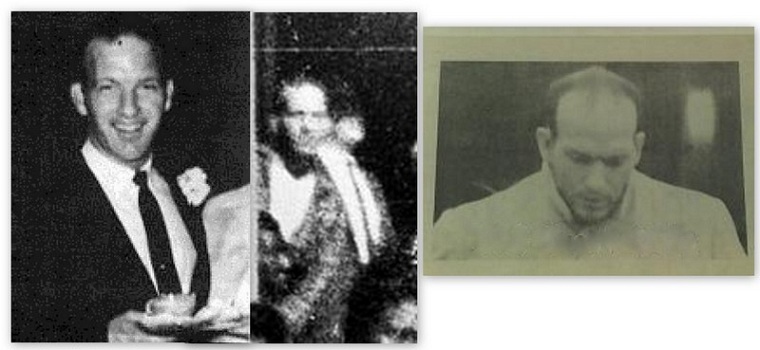
These two pictures below were supposedly taken close to the same time, and there is a chance that they were taken on the same day. Look at those hairlines. What a disgrace that the FBI released such a false and fabricated picture. It is no wonder that the FBI, as well as the Dallas Police, tried so hard to prevent anyone from photographing him. Thank God for Mark Lane.
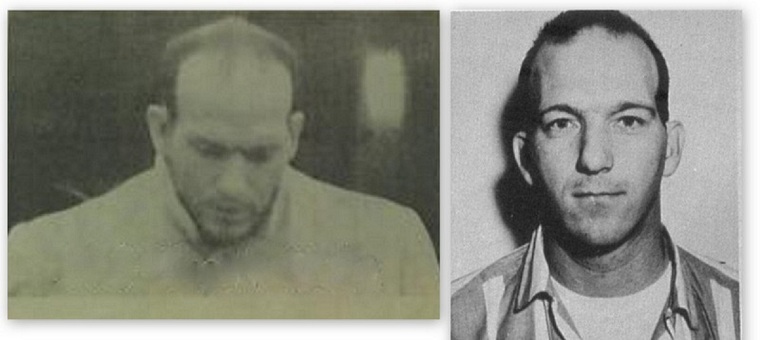
Other than having that indentation front and center, FBI Lovelady's hair looks as thick as a rug! And the shortness of his hair, as depicted, eliminated the need to show individual strands of hair, which would have been hard to do or impossible. Behold the evil doings of the Federal Bureau of Investigation. What a monstrous cover-up.
A concerted effort was made after the assassination to keep Billy Lovelady out of sight. Newspapers were told not to seek pictures of him. The New York Herald Tribune sent a photographer to Dallas to photograph Lovelady, but he was detained by police, threatened with charges, and ordered to leave town. The Warren Commission included no image of Lovelady in their report, and they apparently did not make use of the FBI photos of him. Lovelady never testified before the Commission, but rather to one of their lawyers. The decision to declare Lovelady to be Doorman was reached without ever using an image of him.
Obviously, the need for Billy Lovelady to be Doorman did not exist before the assassination. Nobody knew that Lee Oswald was going to step outside and be captured for eternity on film by Ike Altgens. In order to obfuscate the identity of Doorman, they had to improvise. Lovelady's short-sleeved shirt was not a match to Oswald's, so using Lovelady for Oswald could not have been a pre-conceived plan. It looks like they simply overlooked the incompatibility of the shirts, and when they realized the mistake, they had to scramble. By changing the claim about Billy's shirt--making it the long-sleeved, checkered one-- they were able to salvage him as a stand-in for Doorman. Certainly on the day of the assassination, Billy was unaware of any of this. And since he was willing to show the FBI the red-and-white striped, short-sleeved shirt months later--on 29 February 1964--and pose in it, we presume he was still maintaining at that time that he wore the short-sleeved shirt, and that he was telling the truth.
Making Lovelady into Doorman was a practical solution to a pressing problem. It wasn't him, but Billy was pressured severely to get with the program. He knew what was expected of him, and he delivered. Was it for financial reward? Was it in fear of his life? Perhaps it was both. But this point is not in doubt: he could not have gone for months being mistaken about which shirt he wore on 22 November 1963. That was too important for him to be wrong about for so long. And had he been wrong, had he misremembered--his wife or someone else would have caught it. They would have reminded him, "No, Billy, you didn't wear the striped shirt; you wore the plaid one." It is simply inconceivable that a mistake like that could have persisted for so long.
And, the idea that it was a prolonged misunderstanding between Billy and the FBI is also untenable. It was a very straight-forward question:
FBI agent: "What clothes were you wearing?"
Lovelady: "I wore a red and white vertically striped shirt and blue jeans.
Where is there room for error in that? How does that go wrong?
But regardless, and this is the crucial point: even in his latter claim of having worn the plaid shirt, it was not a match to Doorman's shirt. The styles of the shirts were very different, and the patterns were just as different. What is striking is the match between Doorman's and Oswald's shirts. Look again at the fine matching grain of the two, the matching collars, and the matching V-shaped t-shirts. And notice the discordance with Lovelady's shirt on the right. Which one is the odd man out? Which one doesn't fit with the other two? You can tell at a glance, and there isn't the slightest doubt. It practically jumps off the page, doesn't it?
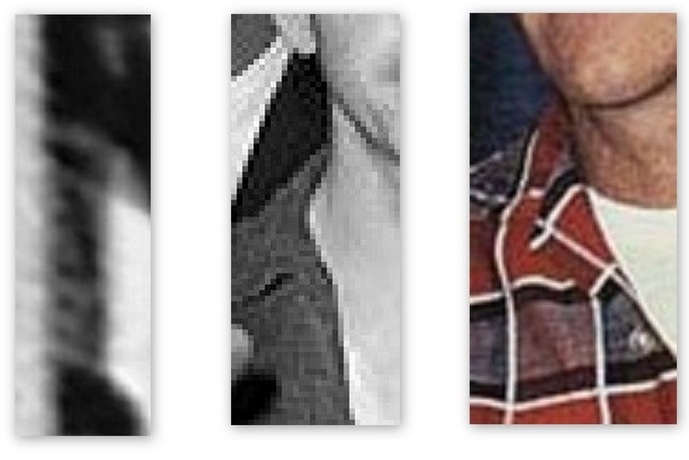
Mr. FRAZIER - No, sir; I don't, because I was back up in this more or less black area here.
Mr. BALL - I see.
Mr. FRAZIER - Because Billy, like I say, is two or three steps down in front of me.
Mr. BALL - Do you recognize this fellow?
Mr. FRAZIER - That is Billy, that is Billy Lovelady.
Mr. BALL - Billy?
Mr. FRAZIER - Right
Mr. BALL - Let's take a marker and make an arrow down that way. That mark is Billy Lovelady?
Mr. FRAZIER - Right.
Mr. BALL - That is where you told us you were standing a moment ago.
Mr. FRAZIER - Right.
Mr. BALL - In front of you to the right over to the wall?
Mr. FRAZIER - Yes.
Mr. BALL - Is this a Commission exhibit? We will make this a Commission Exhibit 369.
(The document referred to was marked Commission Exhibit No. 369 for identification.)
Mr. BALL - That is written in. The arrow marks Billy Lovelady on Commission Exhibit 369.
Mr. BALL - I have got a picture here, Commission Exhibit 369. Are you in that picture?
Mr. LOVELADY - Yes, sir.
Mr. BALL - Take a pen or pencil and mark an arrow where you are.
Mr. LOVELADY - Where I thought the shots are?
Mr. BALL - No; you in the picture.
Mr. LOVELADY - Oh, here (indicating).
Mr. BALL - Draw an arrow down to that; do it in the dark. You got an arrow in the dark and one in the white pointing toward you. Where were you when the picture was taken?
Mr. LOVELADY - Right there at the entrance of the building standing on the top step, would be here (indicating).
Mr. BALL - You were standing on which step?
Mr. LOVELADY - It would be your top level.
Mr. BALL - The top step you were standing there?
Mr. LOVELADY - Right.
How could Billy be "two or three steps down in front" of Frazier, according to Frazier, and also be "on your top level" according to Lovelady? They were referring to the same picture, the same moment in time.
But, the whole exchange is bizarre. Why didn't Mr. Ball begin by saying explicitly, "You'll notice there is already an arrow there, which was drawn by another witness. But, we want to know what you think. So, just ignore that arrow and draw another one to the image of yourself."
And since both Lovelady and Frazier presumably marked the same photo, why didn't they indicate whose arrow was whose? Maybe have them initial it? It is just weird and inexplicable that they would have had them both mark the same copy. Were they economizing? Trying to save money for the taxpayers? There is no valid excuse for this. Is Lovelady's arrow even there at all? Well, brace yourself because we believe it is:

We believe that little mark on the forearm of Black Hole Man is the tail of Lovelady's arrow. The rest of it was, presumably, drawn in the dark space of the arms of Black Hole Man. If that is not part of Lovelady's arrow, then what is it, and how did it get there? It does not appear on any other version of the Altgens photo, only on C E 369. And, if it isn't Lovelady's arrow, where is Lovelady's arrow? It has to be there somewhere. So, that little mark wins by default for being the only other mark on the photo.
Here it is again up-close. If it seems vague and imperfect remember that Lovelady drew it very small, and this is an extreme blowup with all the distortion that that entails. Also, they may have done things to obscure it within the black space. The bottom line is that this is the only other thing that looks remotely like a deliberate mark on the photo besides Frazier's arrow.

Why did Lovelady draw his arrow so small? It's because he knew he wasn't giving Joseph Ball what he wanted, and he wanted to let him down easy. Joseph Ball was like the 800 pound gorilla, and you don't piss off an 800 pound gorilla any more than you have to. This was Lovelady's way of whispering to him: "Psst. This is me. I'm not the other guy. That was Oswald. But, don't worry; I'm not going to tell anybody. I just want to be left alone." Of course, Billy didn't get what he wanted.
I consider Lovelady's arrow on CE 369 to be the second most important image we have exonerating Oswald after Oswald in the doorway. Remember that we concluded that Black Hole Man was Lovelady BEFORE his arrow was discovered. Lovelady posed for the FBI on February 29, 1964 wearing the clothes he wore on November 22. In a letter to the Warren Commission, the FBI put it in writing that “Lovelady stated that he wore a red and white striped shirt and blue jeans.” And, he posed in that shirt with it substantially unbuttoned, just like Doorman. Why would he do that unless it was the same shirt that he wore? So, below we have Lovelady in the same outfit three times: once on February 29 and twice on November 22, as captured in the Couch film (center) and the Altgens photo (right).

It would be an extraordinary coincidence if these were anything but the same man.
So, it appears that Billy Lovelady was trying to tell Joseph Ball that he was Black Hole Man, which is why Ball quickly changed the subject. But note that before making this discovery, we had already figured out that Lovelady was Black Hole Man- and the first researcher to come to that conclusion was Richard Hooke.
Billy's life changed tremendously after the assassination. Somehow, this lowly warehouse worker acquired the financial means to start his own trucking company in Denver. Wasn't that fortunate? Who says America isn't the land of opportunity? But then, his luck changed for the worse. Not long before the HSCA released its Final Report in 1979, he suffered a fatal first heart attack at the age of 41. Statistically, the odds of it happening were less than 1 in 10,000.
The bottom line is that there are no legitimate images of Billy Lovelady from 11/22/63. None. Every one of them is fake, meaning that they were impostors. We don't say that Lovelady impostors were there on 11/22/63, rather, they were added to the films later. The images taken by CBS in 1967 and Robert Groden in 1976 were really Lovelady, but they were doctored. The Mark Lane photo of Lovelady with the protruding ears is the only reliable, authentic image there is of him. It was an unauthorized photo taken by Mark Lane or a photographer in his employ, taken a few months after the assassination on a street in Dallas. Again: it is the only one for which we have complete confidence. Here are all three of those images, chronologically; the Mark Lane photo from 1964, the CBS photo from 1967, and the 1976 Robert Groden one.

The image taken by Mark Lane on the left was taken right around the same time as the FBI photographs; it was the winter of 1964. But, look at them side by side below. Do you notice how much balder he looks in the image taken by Mark Lane on the left? We insist that they doctored Lovelady's hair in the FBI photos to match what they had done to Doorman, where they duplicated the hairline of Young Lovelady. They also got rid of his protruding ears. You know that something is wrong because these are supposed to be same man/same time.

When you compare FBI Lovelady to Doorman, you see a pretty good match of their hairlines. But, it's nothing compared to the match between Young Lovelady and Doorman. Talk about matching hairlines! Wow! That's spot-on!

The photo on the left was taken in the 1950s, probably about 1957. Notice how his hairline matches Doorman's perfectly--to a tee. It's not just that the hairlines are the same, it's that the length of the hair, the lay of the hair, the twist of the hair, everything is the same. It's almost as if Billy had his hair a certain way back then, and then he didn't lie down or shower or do anything to change it for 7 years, and the length remained the same. It also meant that he didn't lose any hair in 7 years, even though 3 months later he would be practically bald. So, seemingly, his hair remained stable for 7 years and then fell out in droves. But, the truth is that young Billy underwent rapid balding, and his hairline did not remain stable for 7 years. It was just the opposite. It's apparent that they altered Doorman's hairline to match young Billy's. Why did they use an early picture of him? It was probably because they did not have a current one, and they did not realize how much hair he had lost.
And, after they put in the fix, they flipped the image of Young Lovelady to conceal what they had done. The flipped version is the only one that you can find online, and it is the one published in the HSCA Final Report which came out in January 1979. Compare them below. Flipped is on the left, and real is on the right. We had to unflip the flipped one.

So, it started with the hairline of Young Lovelady, and Doorman's hairline was matched to it. Then, the FBI photo of Lovelady from 29 February 1964 was altered to match what they had done to Doorman. Oh, what a tangled web they weaved . . . Below are two fake hairlines.

So, both hairlines above were matched to Young Lovelady's. But again, that would have meant 7 years of stable hair for Billy, which was impossible, as he underwent rapid, early, and severe balding. Doorman's hair actually matches Young Lovelady's the best. Conclusion: they used the image of Young Lovelady to create Doorman's hairline.

Another image of Billy Lovelady appears in the book, Forgive My Grief, Volume IV by Penn Jones. It's in the back of the back, adjacent to the inside back cover and it's similar to the picture in Mark Lane's Rush to Judgment. If anything, it's better because it shows his head and his hair completely. This is our best view of the real Billy Lovelady from the time of the assassination.

Again, notice how Lovelady's hair compares to Doorman's. Once more, it is clear that Doorman has Lovelady's hairline from a bygone era. No way was that his look in 1963.

These two pictures below were supposedly taken close to the same time, and there is a chance that they were taken on the same day. Look at those hairlines. What a disgrace that the FBI released such a false and fabricated picture. It is no wonder that the FBI, as well as the Dallas Police, tried so hard to prevent anyone from photographing him. Thank God for Mark Lane.

Other than having that indentation front and center, FBI Lovelady's hair looks as thick as a rug! And the shortness of his hair, as depicted, eliminated the need to show individual strands of hair, which would have been hard to do or impossible. Behold the evil doings of the Federal Bureau of Investigation. What a monstrous cover-up.
A concerted effort was made after the assassination to keep Billy Lovelady out of sight. Newspapers were told not to seek pictures of him. The New York Herald Tribune sent a photographer to Dallas to photograph Lovelady, but he was detained by police, threatened with charges, and ordered to leave town. The Warren Commission included no image of Lovelady in their report, and they apparently did not make use of the FBI photos of him. Lovelady never testified before the Commission, but rather to one of their lawyers. The decision to declare Lovelady to be Doorman was reached without ever using an image of him.
Obviously, the need for Billy Lovelady to be Doorman did not exist before the assassination. Nobody knew that Lee Oswald was going to step outside and be captured for eternity on film by Ike Altgens. In order to obfuscate the identity of Doorman, they had to improvise. Lovelady's short-sleeved shirt was not a match to Oswald's, so using Lovelady for Oswald could not have been a pre-conceived plan. It looks like they simply overlooked the incompatibility of the shirts, and when they realized the mistake, they had to scramble. By changing the claim about Billy's shirt--making it the long-sleeved, checkered one-- they were able to salvage him as a stand-in for Doorman. Certainly on the day of the assassination, Billy was unaware of any of this. And since he was willing to show the FBI the red-and-white striped, short-sleeved shirt months later--on 29 February 1964--and pose in it, we presume he was still maintaining at that time that he wore the short-sleeved shirt, and that he was telling the truth.
Making Lovelady into Doorman was a practical solution to a pressing problem. It wasn't him, but Billy was pressured severely to get with the program. He knew what was expected of him, and he delivered. Was it for financial reward? Was it in fear of his life? Perhaps it was both. But this point is not in doubt: he could not have gone for months being mistaken about which shirt he wore on 22 November 1963. That was too important for him to be wrong about for so long. And had he been wrong, had he misremembered--his wife or someone else would have caught it. They would have reminded him, "No, Billy, you didn't wear the striped shirt; you wore the plaid one." It is simply inconceivable that a mistake like that could have persisted for so long.
And, the idea that it was a prolonged misunderstanding between Billy and the FBI is also untenable. It was a very straight-forward question:
FBI agent: "What clothes were you wearing?"
Lovelady: "I wore a red and white vertically striped shirt and blue jeans.
Where is there room for error in that? How does that go wrong?
But regardless, and this is the crucial point: even in his latter claim of having worn the plaid shirt, it was not a match to Doorman's shirt. The styles of the shirts were very different, and the patterns were just as different. What is striking is the match between Doorman's and Oswald's shirts. Look again at the fine matching grain of the two, the matching collars, and the matching V-shaped t-shirts. And notice the discordance with Lovelady's shirt on the right. Which one is the odd man out? Which one doesn't fit with the other two? You can tell at a glance, and there isn't the slightest doubt. It practically jumps off the page, doesn't it?
